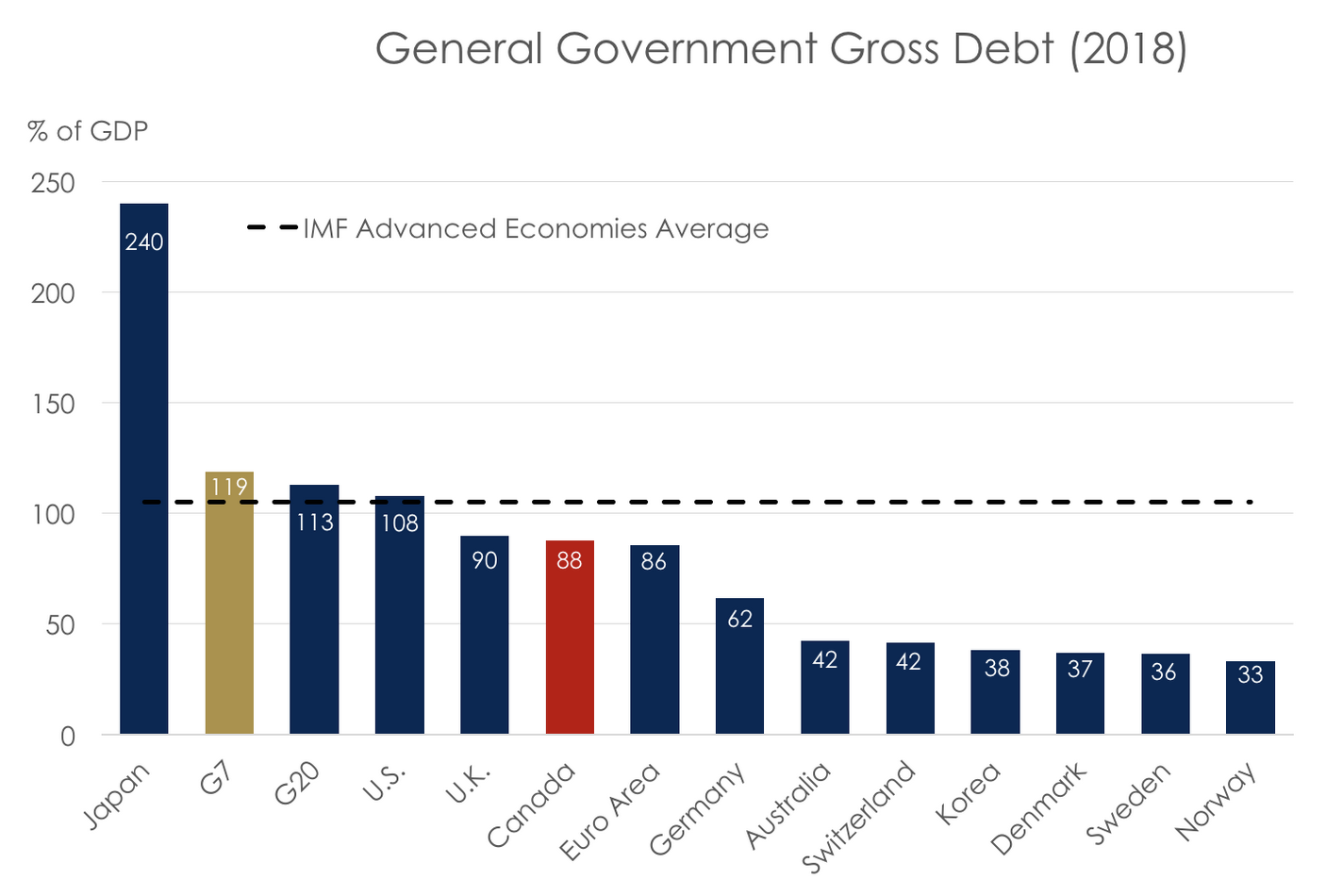And to preserve their independence, we must not let our rulers load us with perpetual debt.
My advice would be, as you consider fiscal policies, to keep in mind and look carefully at the impact those policies are likely to have on the economy’s productive capacity, on productivity growth, and to the maximum extent possible, choose policies that would improve that long-run growth and productivity outlook.
The Keynesian idea is once again accepted that fiscal policy and deficit spending have a major role to play in guiding a market economy.
The spirit of a people, its cultural level, its social structure, the deeds its policy may prepare – all this and more is written in its fiscal history, stripped of all phrases. He who knows how to listen to its message here discerns the thunder of world history more clearly than anywhere else.
Western governments, by and large, have used and abused fiscal policy since the 1970s. State spending has ballooned. Rather than investing in infrastructure, education, or research, these spending increases have gone mostly to social spending, which has provided short-term relief for put-upon majorities while compounding their long-term problems.
This spending was financed in part by raising taxes on work and consumption, which disproportionately fell upon the working and middle classes even as taxes on the wealthy and corporations stagnated or declined. These poorly designed changes to the tax system made marginal labor activities economically unviable, pushing up unemployment, which in turn necessitated more social spending.
What wasn’t financed with taxes was financed with debt. Rather than pay down debt when economies were booming, Western governments have allowed ever larger debts to accumulate over several business cycles. Debt levels are now so high that these governments have essentially exhausted their abilities to enact fiscal policy. As we saw with the last financial crisis, the burden of bailing out an economic system in crisis fell on the shoulders of monetary policy, which has now become the only game in town. This, to say the least, does not bode well for the West’s prospects of facing down its next crisis.
FISCAL POLICY IN THEORY
Fiscal policy, how the state collects and spends money, should be guided by a relatively simple set of principles. The state should collect the revenues it needs with parsimony, trying not to overburden the population, economy, or taxpayers. It should do so in the least harmful way, to avoid interfering with or disrupting the economy. It should do this in an equitable way, avoiding taxes on those who cannot pay, and making a distinction between revenues that have been earned with hard work and those that have not. These revenues should first be used primarily to pay for the core functions of the state, the backbone of our society, including the administration of justice, policing, and defense. It should then be used for investing in the economy of the future along the sort of long-term time horizon that only the government of a nation can have. This means funding education, research, and infrastructure. Finally, fiscal policy should support the most vulnerable citizens, providing a safety net in case individuals face temporary downfalls or long-term incapacitation.
Counter-cyclical fiscal policy can and should also be used to lessen the impact of recessions, though not to eliminate them altogether. But budget deficits should not, over the economic cycle, be allowed to surpass net investment. Doing so would create a debt that would not pay for itself and would redistribute wealth upwards, as wealthy bondholders profit from the interest paid by all taxpayers.
FISCAL POLICY: THE REALITY
While these principles sound simple enough, in reality fiscal policy has departed starkly from them since the first oil crisis in the 1970s.
In their willingness to smooth over business cycles and their efforts to “buy votes” with government handouts, Western nations have increased their budget deficits over the past four decades. Decreasing inflation made debt financing seem less costly as deficits piled up. The deficits, which allowed governments to achieve a Keynesian juicing of their economies, alleviating the pain of the structural changes we have been looking at, gradually increased the national debt as a percentage of GDP. In advanced economies, national debt grew from below 40% of GDP in the 1970s to above 100% of GDP in recent years60.
While the beneficial impact of fiscal stimulus to dampen the excesses of the business cycle cannot be denied, neither can the fact that constant deficits create mountains of debt. The deficits, rather than being employed on an exceptional basis at the bottom of the cycle have become structural in nature, occurring throughout the economic cycle. Western countries are rarely in budget surplus and thus end up building debt over the cycle.The increase of the debt-to-GDP ratio is a fundamentally negative development for the lower and middle classes. The debt acts as a transfer of wealth from average taxpayers to the better off. The mechanism of this wealth transfer is relatively simple, as the interest paid to finance payment to the bond holders is funded by the general budget. Thus, bondholders, by definition people with savings, receive payments financed by the tax collected from the general population. Effectively, the debt sucks in a percentage of income revenues and spits it back out to wealthy savers in the form of interest payments.
The impact of the deterioration of fiscal policy has been blunted by quantitative easing, so we do not yet fully feel it. The massive acquisition of government bonds by the central banks has pushed interest rates down. That has translated, despite a higher national debt, in lower interest rate payments. The U.S. federal spending on the national debt interest payments, as a percentage of federal spending, has, for instance, dropped from about 20% in the ’90s to 10% today. Nonetheless, because of the rise of the aggregate debt, interest payments on national debt represented about 2% of GDP for the advanced economies. If central banks halt or reverse QE, interest rates would increase substantially and interest payment as a percentage of the economy would shoot up like never before. In effect, QE is allowing us to temporarily deny the reality of the debt until QE is resolved, either by cancellation of the debt acquired by the central banks or in some other way.
Over the last century, government expenditures as a proportion of the economy have steadily risen alongside the rise of economic progress and democracy, reflecting higher demands on the government as well as a central role for the state in promoting economic development and social cohesion. The level of government spending as a percentage of GDP has always varied somewhat within the Western world.
In the ’70s, government spending as a percentage of GDP in the OECD ranged from 20% in Japan to 35% in the UK, levels at which they had been fairly stable since the end of World War II. After the ’70s and the oil shock, however, government spending as a proportion of the economy increased steadily in all industrial countries. While these figures continue to fluctuate, they are now generally in a range of 35% to over 50% of GDP, with France being the largest spender among the G7.61 The U.S. is at the lower end of the range with total spending (local, state, and federal) hovering between 35% and 40% of GDP in recent years.
These are increasingly unsustainable numbers. This spending62 has to be financed by taxes, increased debt, or debt financing63. Not only does over-taxing or racking up debt damage the economy, and, potentially, social cohesion, it also means that in times of crisis the ability of the state to swoop in and prop up the economy has deteriorated as states are already overextended. In effect, too much government spending on a permanent basis reduces the ability of the state to pursue an active, counter-cyclical fiscal policy.
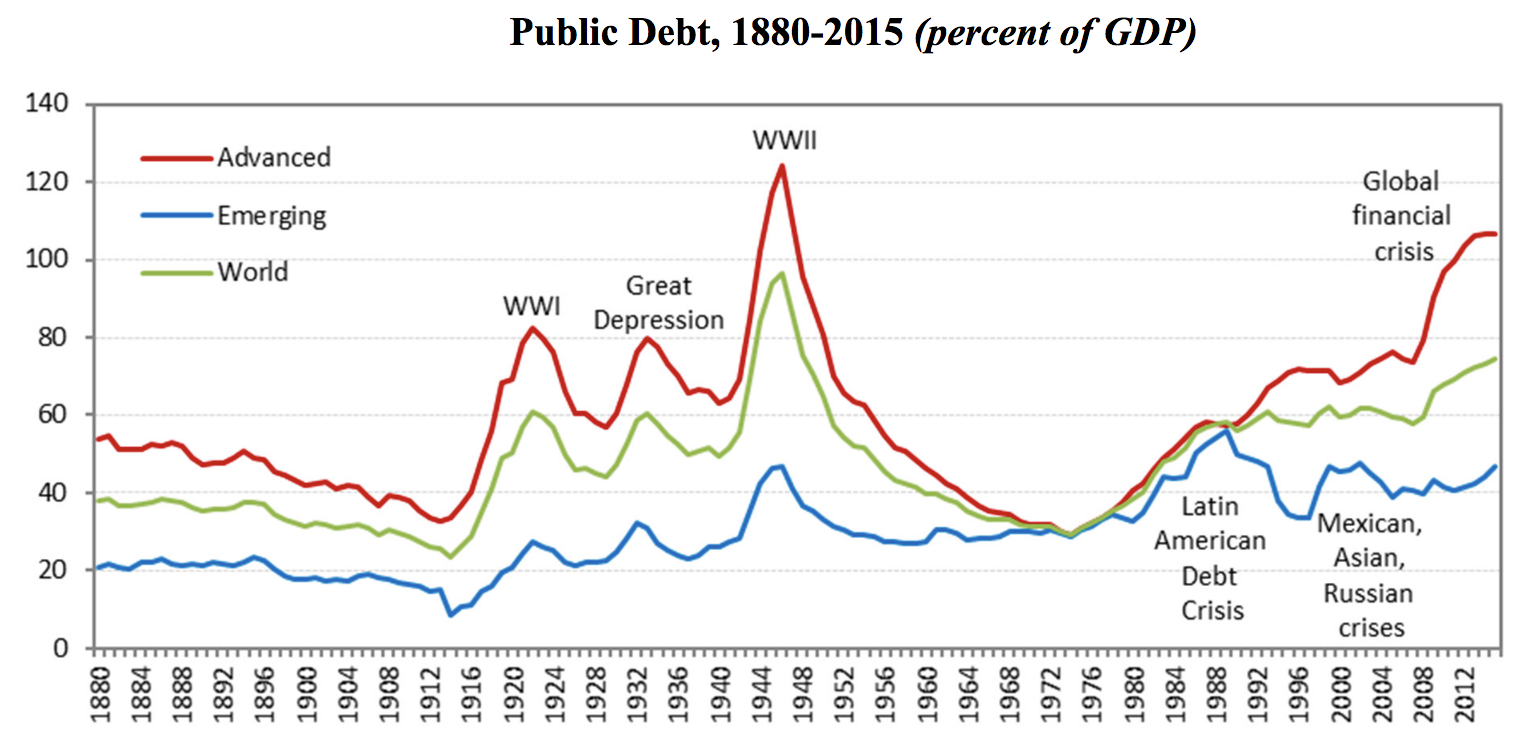
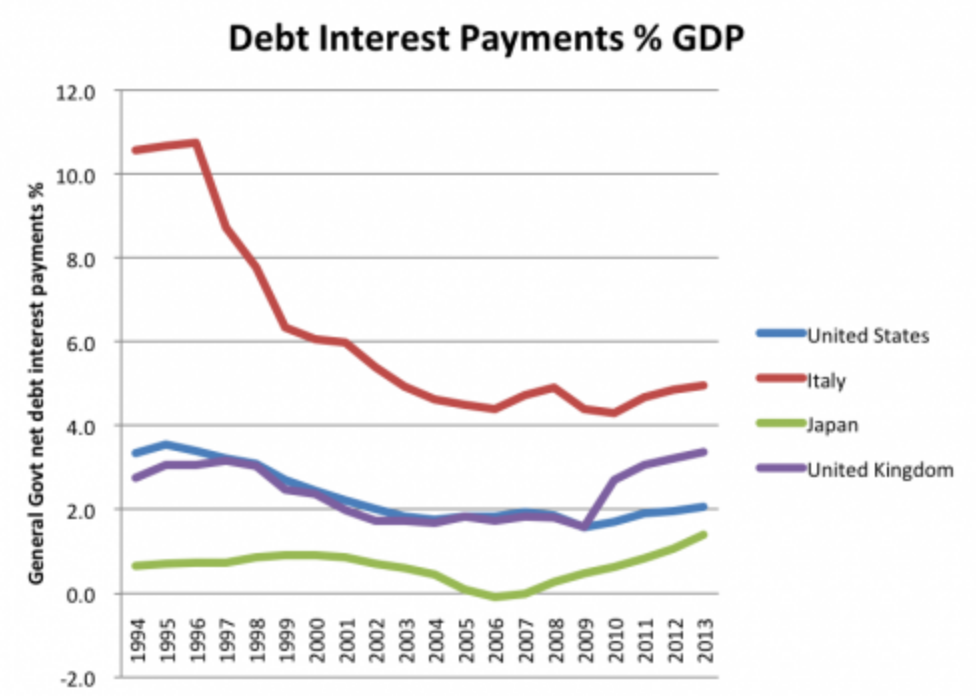
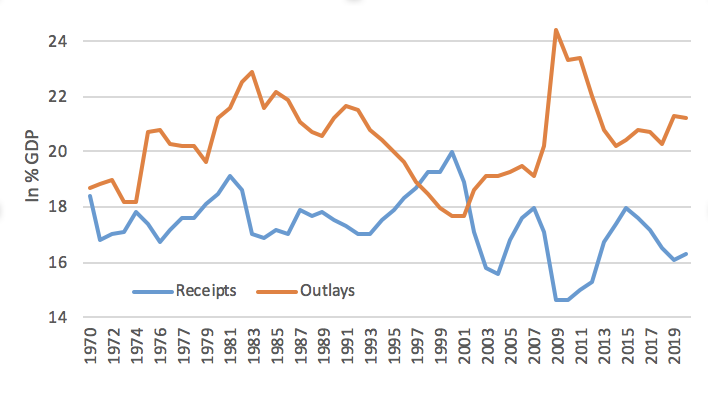
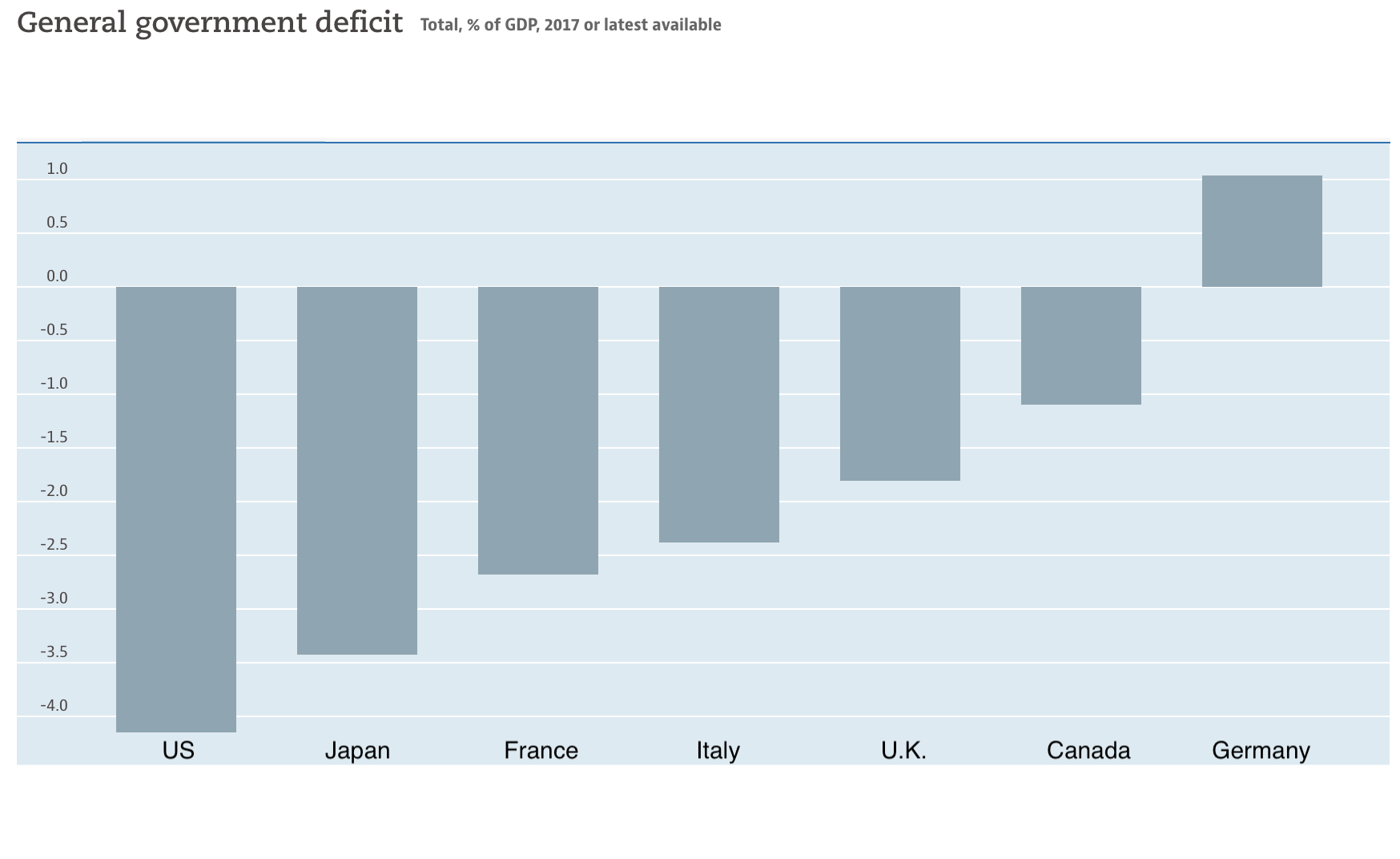
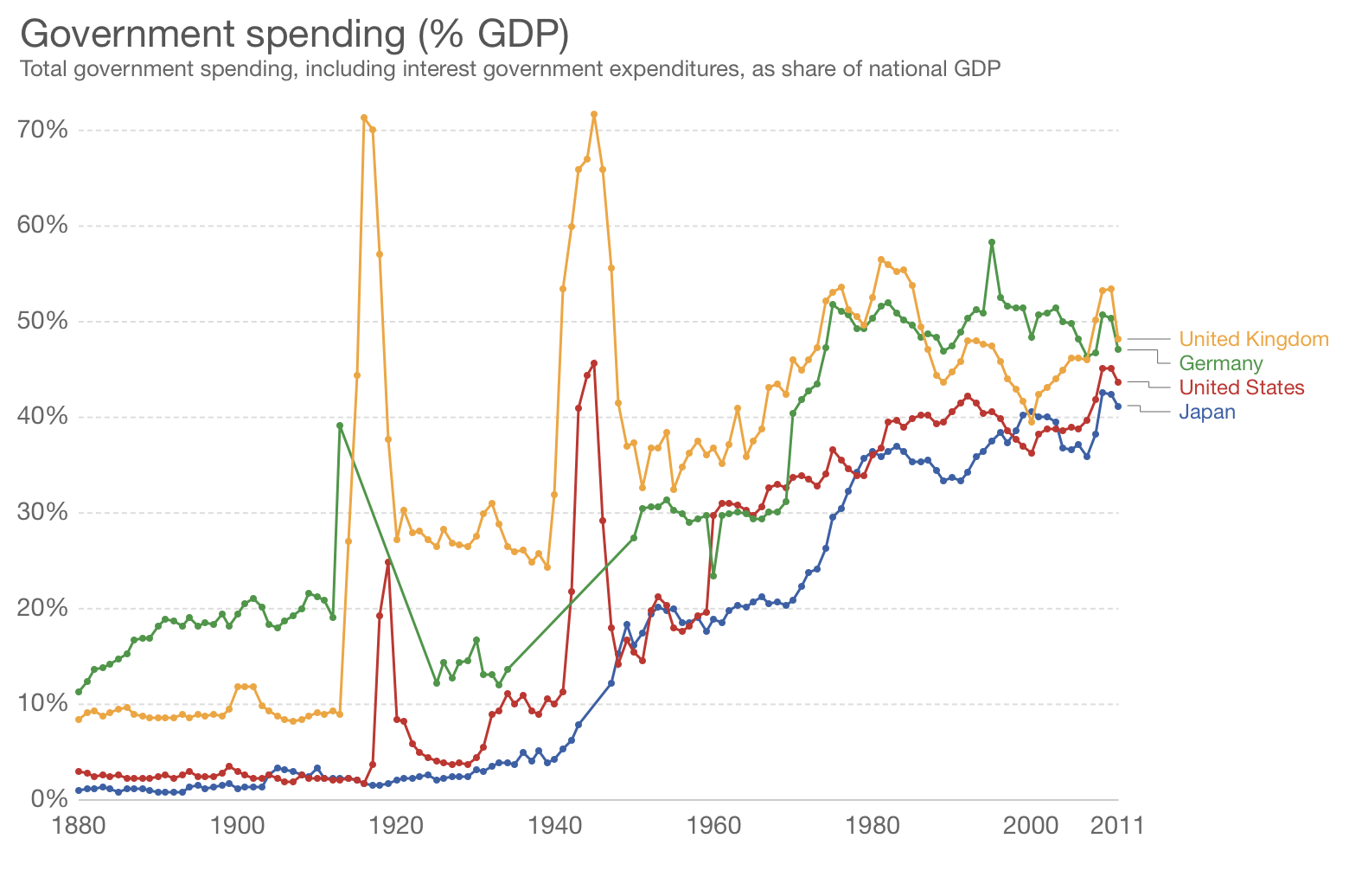
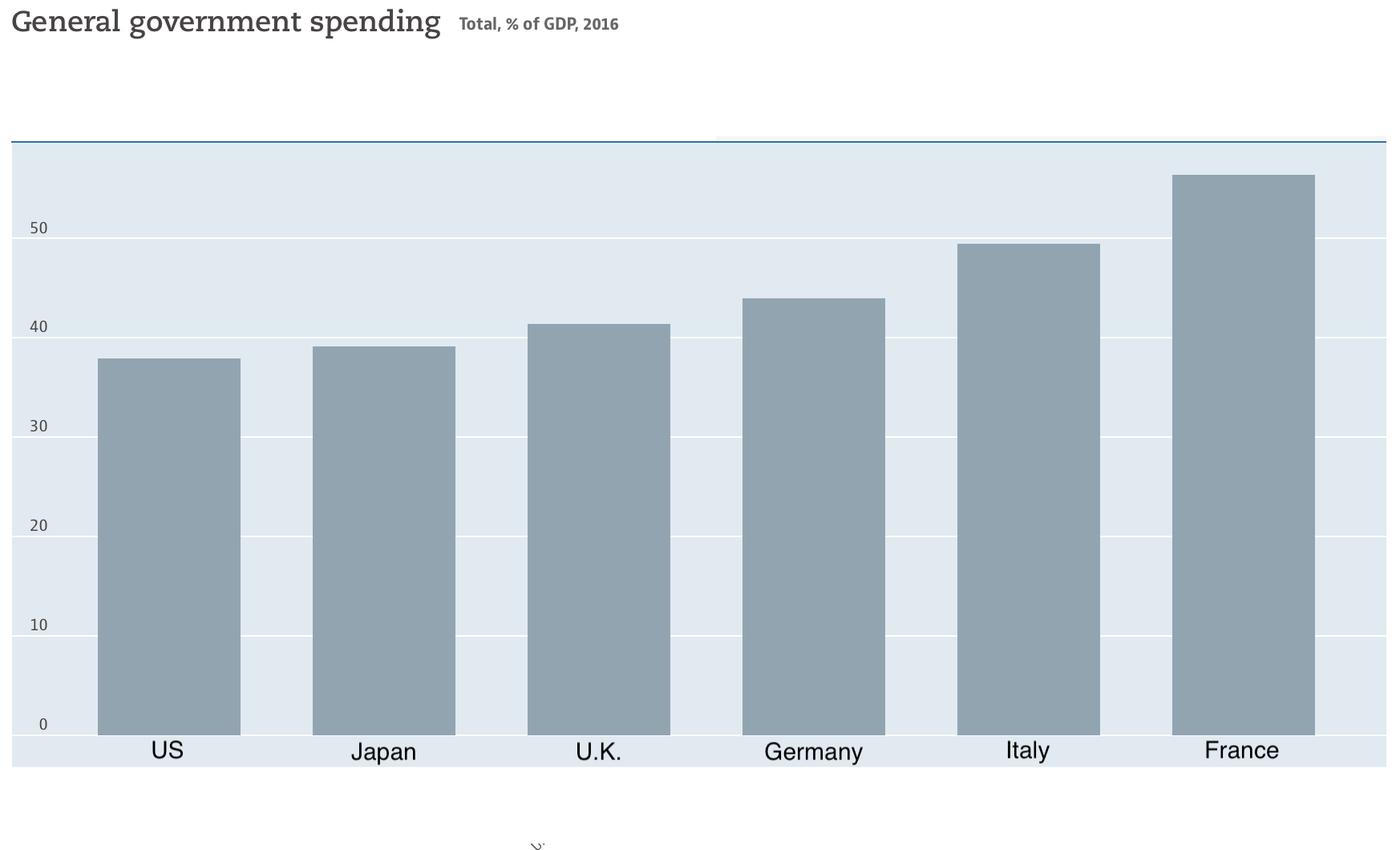
SPENDING
Fiscal policy is not simply the net increase or decrease in deficits and debt. The form of government spending and the taxes levied to finance it are equally important. For instance, if deficit spending is used to finance long term investments that would improve the economy over the long term; it may benefit wealthy bond holders but it would benefit society as a whole even more. It would thus be a win-win. This is often referred as the golden rule. A country can run a deficit provided that the deficit is invested in long-term projects, such as infrastructure. In today’s knowledge economy, one could argue that research and development or education should be included in that category. That is not what has been happening.
SOCIAL SPENDING CROWDS OUT STATE INVESTMENT
For all the manifold reasons discussed in previous chapters, populist resentment has been steadily building for decades. Elites, seeking to prolong the status quo as long as possible, have resorted to a time-honored solution: disbursements from the public treasury to pay for the temporary mollification and distraction of the downtrodden masses. The ancient Romans called this “bread and circuses.” We call it social spending. While it has the benefit of relieving short-term political pressures, it fails to address underlying structural problems and, in fact, exacerbates them.
This spending now accounts for a majority of national budgets in developed countries, accounting for over 20% of GDP in the OECD as a whole. By comparison, state spending on education, research and infrastructure, which one could consider investments in the future, represents less than 10% % of GDP64 in OECD member states. In other words, OECD governments spend more than twice as much on short term social consumption as they spend on investment. Fifty years ago, these figures were roughly equal.
The largest component of social spending is pension payments, which have been steadily rising with the aging of the population. But when you consider the demographic implications, the opposite policy choice should have taken place. Governments, rather than decreasing investments to pay for increasing pensions outlays, should have encouraged investments that would later have paid for increased retirement spending.
The OECD governments should have, but did not, increase investment in anticipation of the demographic change that is now belatedly setting in. Fundamentally, aging populations imply that fewer workers have to support more retirees, which can only be done by being more productive, which requires investment. This is typical of the lack of long-term vision in Western governments that have gotten used to buying votes (using borrowed money) rather than earning popular support via good governance.
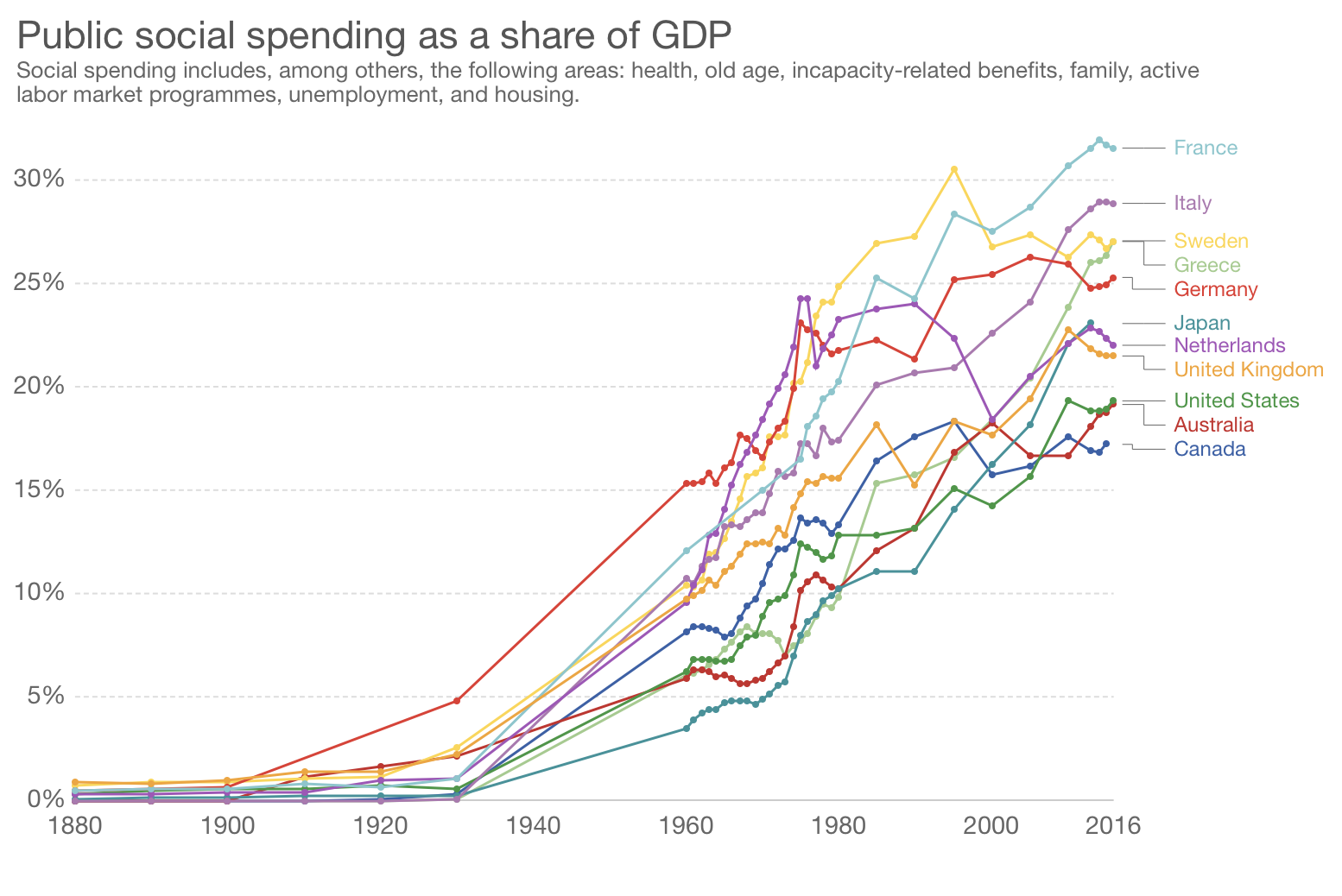
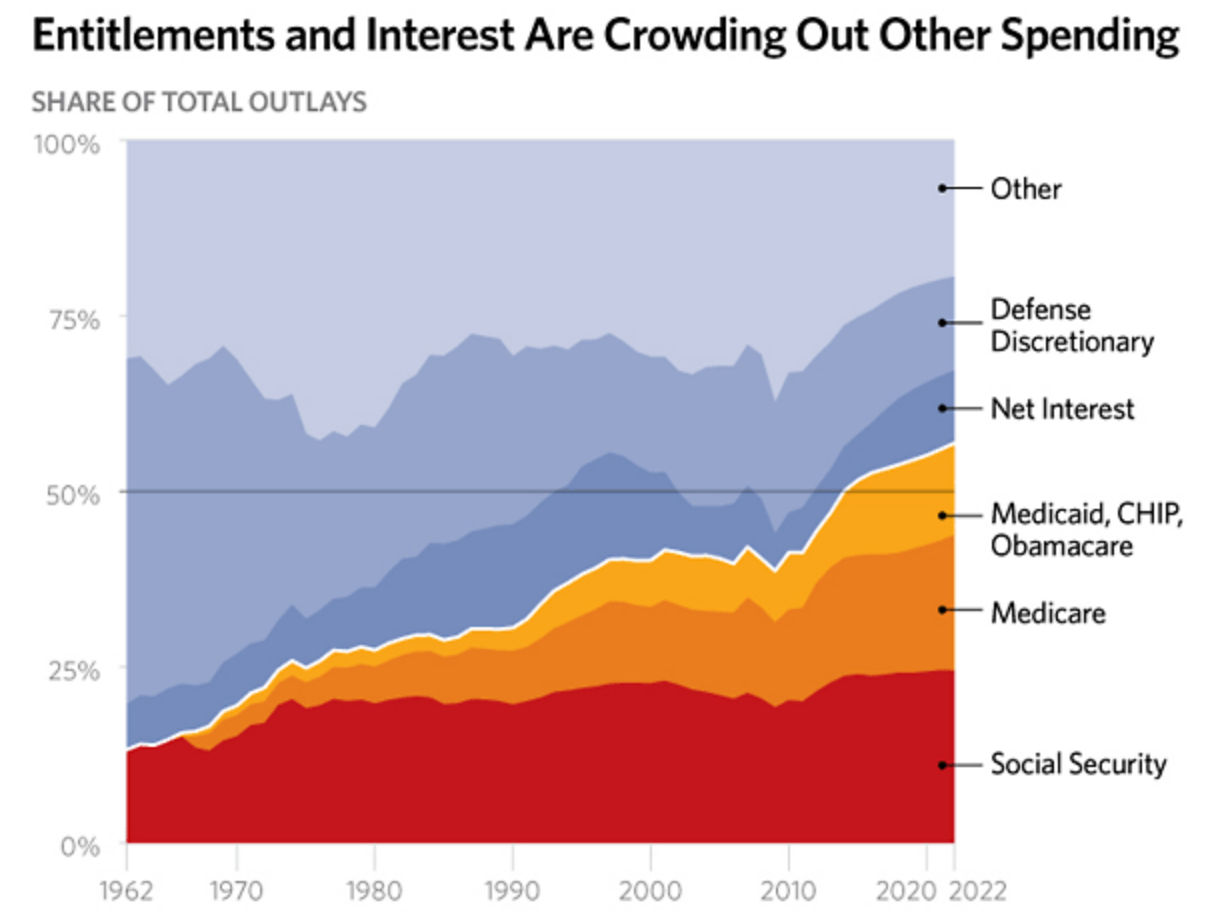
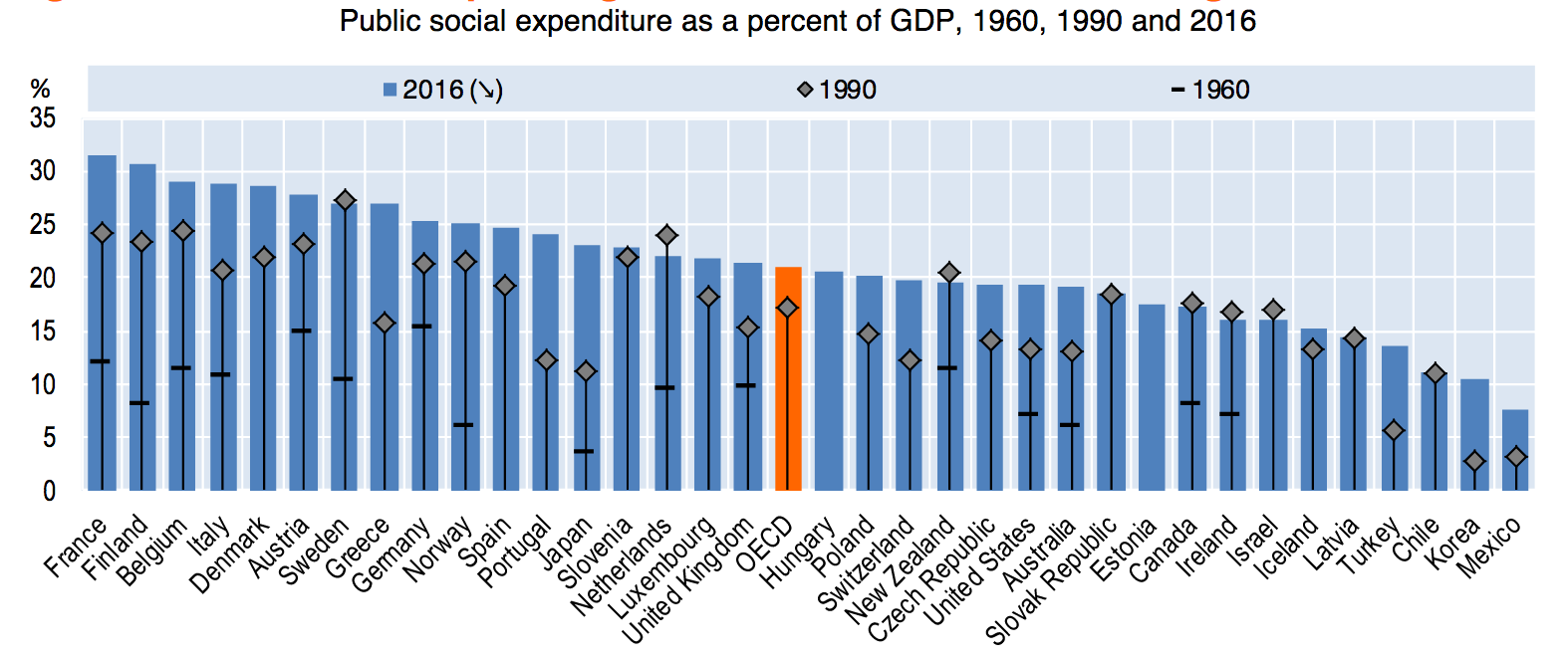
ENTITLEMENT SPENDING
The largest increase in government spending has been on entitlement programs (health, old age, incapacity-related benefits, family, unemployment, and housing), which have increased from about 10% of GDP in the ’70s to about 25% of GDP today65.
At first glance, one would assume that higher social spending by governments would buy social peace and prevent popular contestation of the system by the less well off. This was indeed the case for a long time, but government social spending has now reached levels never seen before.
It is because the governments were not able or willing to foster housing supply, to control monopolies, to restrain immigration and trade with low income countries, to control health costs, that they resorted to higher social spending instead. But the cost of these increases has become unsustainable. The next time there is a need for a burst of government spending to mitigate a recession or address some other crisis, states might not have the means to keep the social peace.
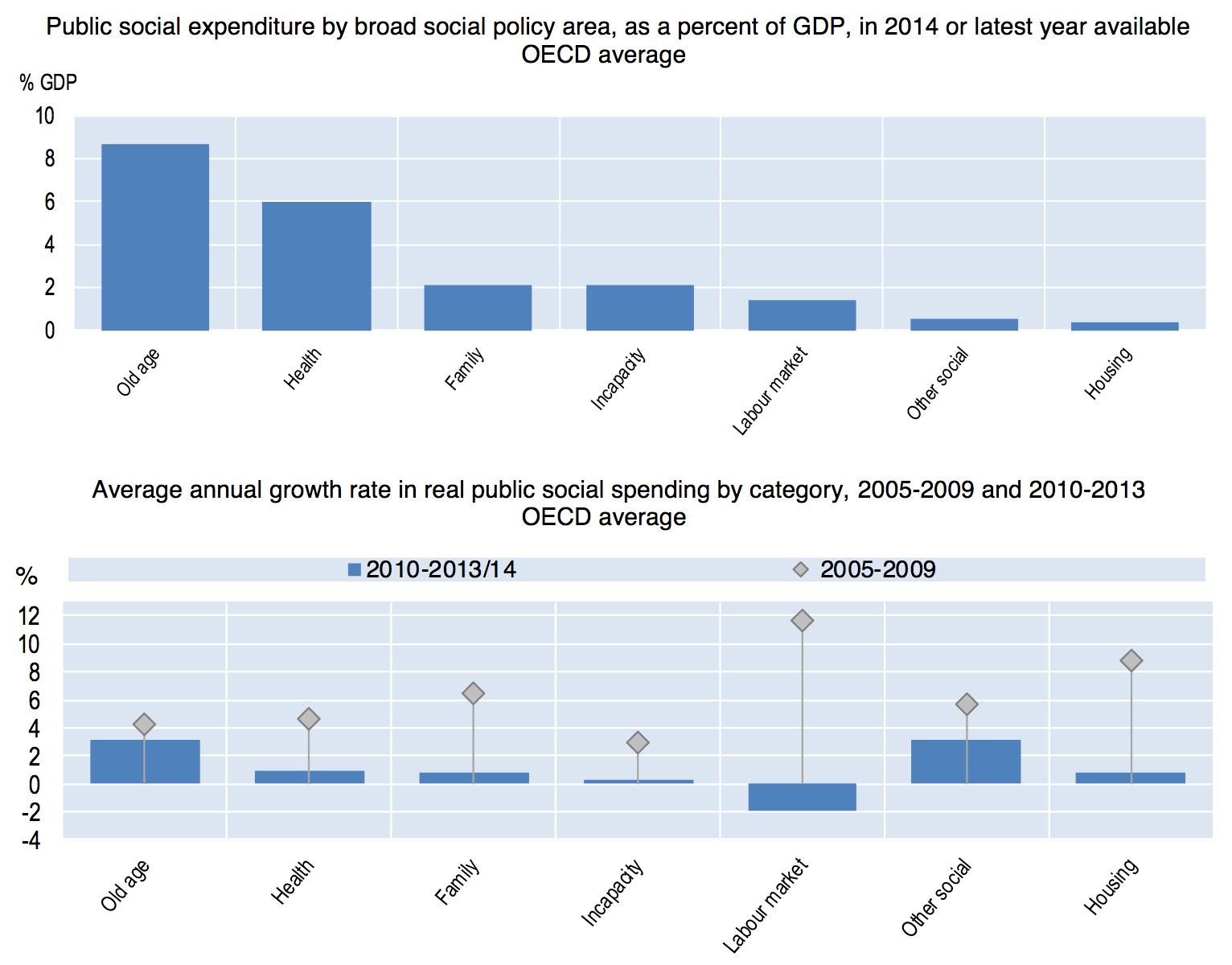
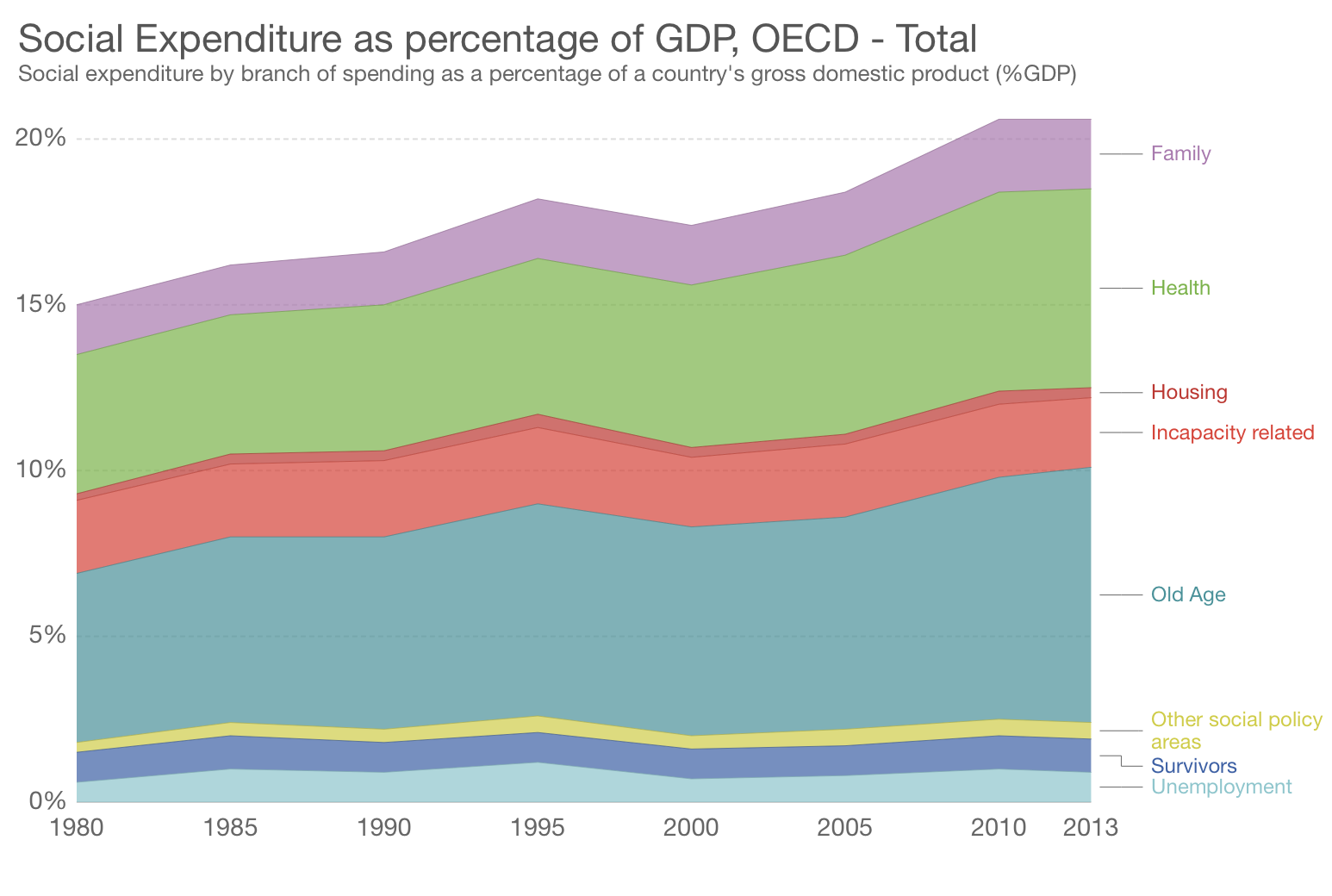
MISSPENDING: THE EXAMPLE OF MAASTRICHT TREATY INTEREST REDUCTION GAINS
If one considers the Maastricht criteria – which set limits on the monetary and fiscal policies of EU member states – the evolution of government spending is particularly striking. On the surface, these were meant to reduce national debts. The deficits may have been reduced, but this was achieved by slashing investment while increasing social spending. In effect, most southern European countries have followed the opposite of the golden rule. Let us call it the “leaden rule” because it has dragged these societies down.
Initially, the debt reductions imposed by the Maastricht straitjacket led to savings on interest. But governments allocated all of the money that was saved on servicing debt, and then some to social spending. Infrastructure, education and research budgets were cut. These cuts aggravated the long-term problems of these countries by further reducing their long-term competitiveness, creating a vicious cycle. Indeed, the reductions in national debt have proven, unsurprisingly, temporary. These countries, sapped of human capital and infrastructure, have repeatedly failed to bounce back from economic downturns, which have dealt severe blows to their GDPs several times since the Maastricht criteria were adopted.66
According to the European Commission’s database, from 1995 to 2015, Germany reduced social expenses by 0.5 percent of GDP. In the same period, Italy has increased social expenditures by over 6 percent of GDP and France by close to 4 percent of GDP. Italy essentially spent all of its interest rate savings – and France’s governments a multiple of their interest rate savings – on social programs, chief among them pensions and health. In 2012, pension expenses accounted for 15.8% of GDP in Italy and 13.8% in France, close to double the OECD average of 7.9%. OECD
This is critical to understanding the current conflict within the European central banks. The euro was billed as heralding a new era in which Europe’s more profligate members would accept German fiscal orthodoxy, enshrined in the Maastricht criteria. The Maastricht straitjacket would encourage fiscally prudent behavior while lowered interest rates would allow for reduced national debts and renewed infrastructure investment.
The subsequent drop and convergence in rates brought material savings for government budgets across the euro zone, including Germany’s. Interest payments made by governments dropped across the board, but predominantly in southern periphery countries. In Italy it dropped by a staggering 7% of GDP67.
In short, European states benefited from a prolonged decline in interest payments, only similar in magnitude to what QE has delivered. But while these countries were realizing big savings through reduced interest costs, they misallocated these savings. In fact, they simultaneously reduced investment and increased social spending. This was done to meet the budget criteria imposed by Maastricht while at the same time providing support to citizens as ferocious German competition, no longer stopped by protective devaluations, pauperized entire regions. This, and the buying of votes through handouts at election time.
Having failed to save and invest in the good times, countries were forced to borrow even more when the 2008 financial crisis hit. Italian debt-to-GDP now stands at 130 percent; Portugal’s is similar, and France’s is over 95 percent. Had it not been for the ECB intervention to massively acquire these countries government bonds, interest rates paid on their debt would have increased in line with their increased sovereign default risk. De facto, these countries no longer have the capacity for an expanded fiscal policy.
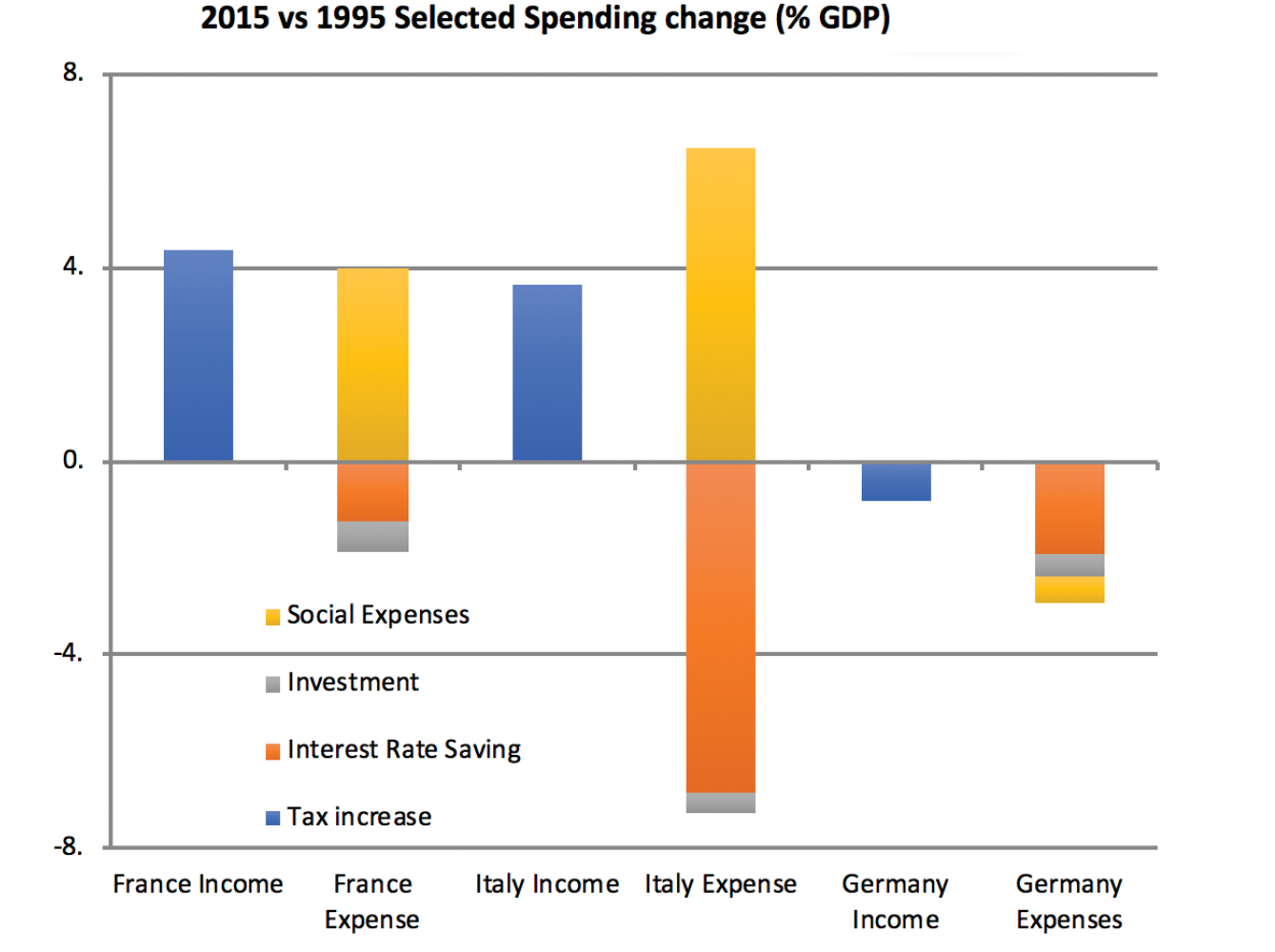
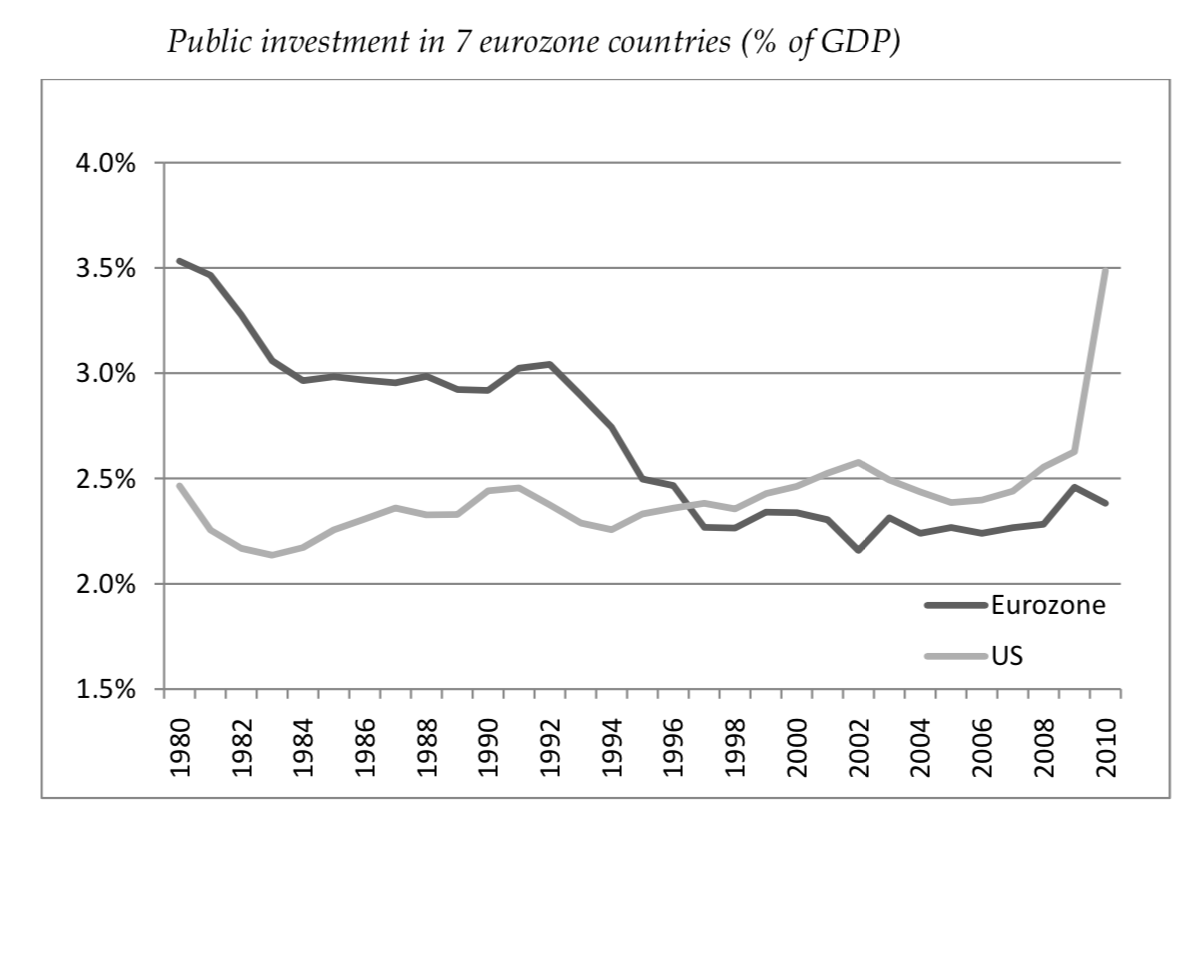
EDUCATION SPENDING
Over the last century, governments’ education spending rose from about 1% of GDP to 5-6% of GDP by the 1970s, a level around which it has hovered since. The level of tertiary education spending has marginally increased from a level of 1.4% of GDP in the ’70s to about 1.6% of GDP today.
A similar story is observable all around the Western world. In the E.U., for instance, government spending on educations stands at about 5% of GDP on average. Higher education accounted for one-fifth to one-third of expenses, or roughly 1.5% of GDP on average. Eurostat
According to the OECD, private expenditure increases spending on education in the EU by 0.3% of GDP and, in the U.S., by 1.7% of GDP. In other words, U.S. universities are mainly funded by private expenditure and without it would find themselves in as poor a state as their European counterparts. Japan and Korea have similarly high private funding for tertiary education, at about 1% of GDP, and total spending on tertiary education of 1.5% and 2.3% of GDP respectively.
On the surface of it, these figures are comforting, with both the general education budget, and higher education budget, stable.
In reality through, a deeper analysis reveals a severe shortfall in higher education. Higher education is clearly the most expensive per pupil. In the E.U., annual spending on higher education per student is about 10,000-15,000 euros, with a wide inter-country range. In the U.S., a year at university costs between $20,000 at the lower end of public universities to about $50,000 at the higher end of private universities.
In fact, in tertiary education, both the cost and the student population have exploded in recent decades. In the U.S., between 1970 and today, the percentage of people 25-29 years old that have completed a four-year college education has approximately tripled from 10% to over 30%. Indeed, master’s degrees are now as common in the U.S. as bachelor’s degrees were at the beginning of the ’70s. In the UK, the equivalent figure rose from the mid-teens to 35% in the same period. Similarly, in Europe, in 2017, about 40% of 30-to-34-year-olds had completed some tertiary education.
While the percentage of students in university tripled, the cost of education increased even more. Public tuition in the U.S. increased from about $2000 in the ’70s to just shy of $10,000, adjusted for inflation, today. In the meantime, public spending, adjusted for inflation, has been stable, not increasing in line with economic growth. Adjusted for inflation, the cost of private tuition grew at a rate well above economic growth, from about $12,000 to $40,000.
In Europe, the state is still overwhelmingly “offering” education, but not paying for it. This results in low tuition and low public subsidy, with students and the state getting exactly what they pay for: little to nothing. Poorly financed public universities are unable to maintain research and education at an adequate level. This has led to the emergence of private higher education.
But this private education is financed by publicly guaranteed loans. In the U.S., and to some extent in the U.K., publicly guaranteed loans have de facto financed the tuition increases. Because for-profit education is poorly regulated, it sometimes leads to scams, with those who graduate from some of the less reputable institutions (and many don’t even get that far) often failing to find suitable employment. As a result, an ever-higher number of loans go bad, leaving the state holding the bag. Having failed to invest, having used badly structured financing mechanisms, the government is likely to have to pay an even higher bill at the end, but without much of the economic and social benefits to society. Meanwhile, an entire generation of students has either not gone to a properly funded university or has been saddled with enormous debt.
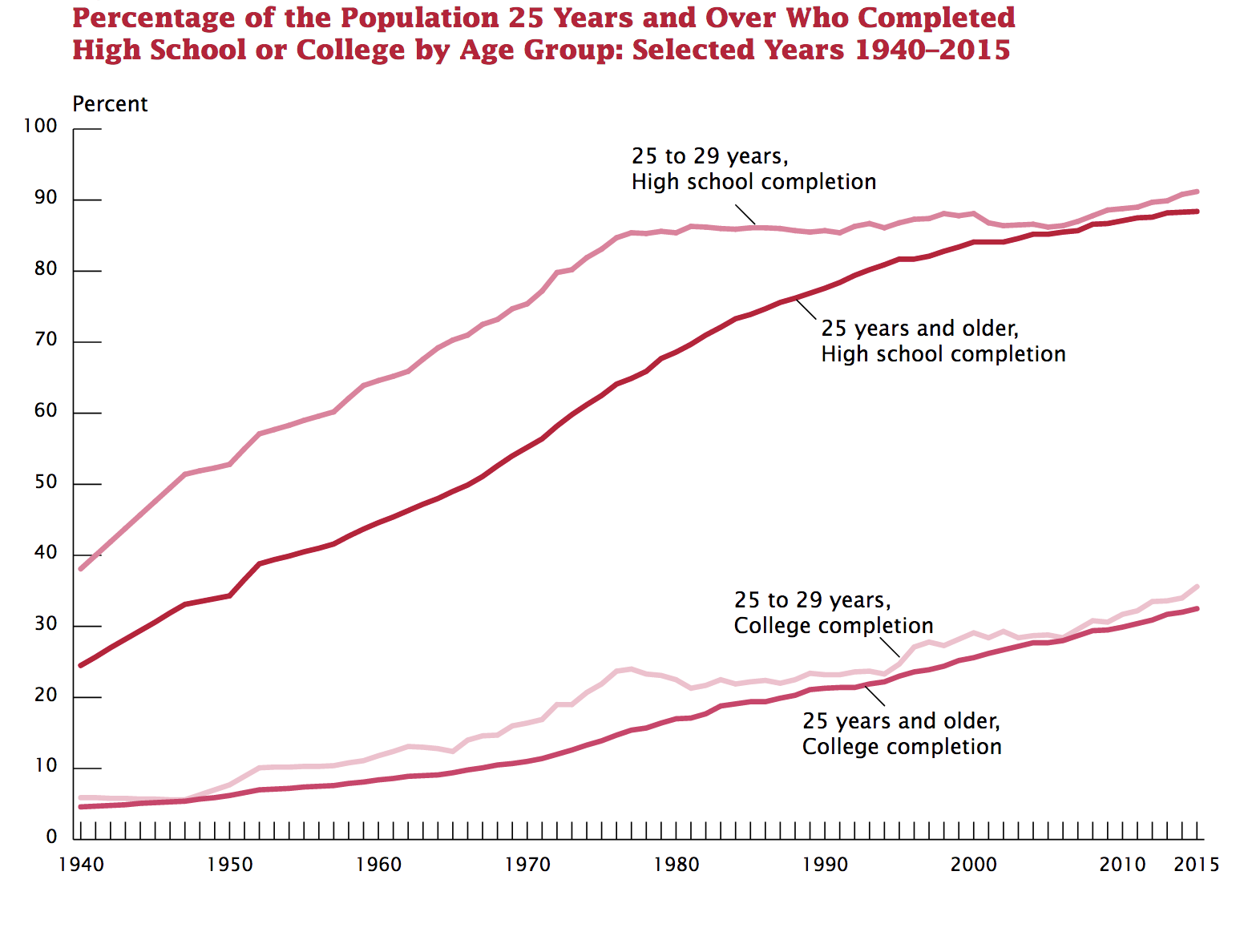
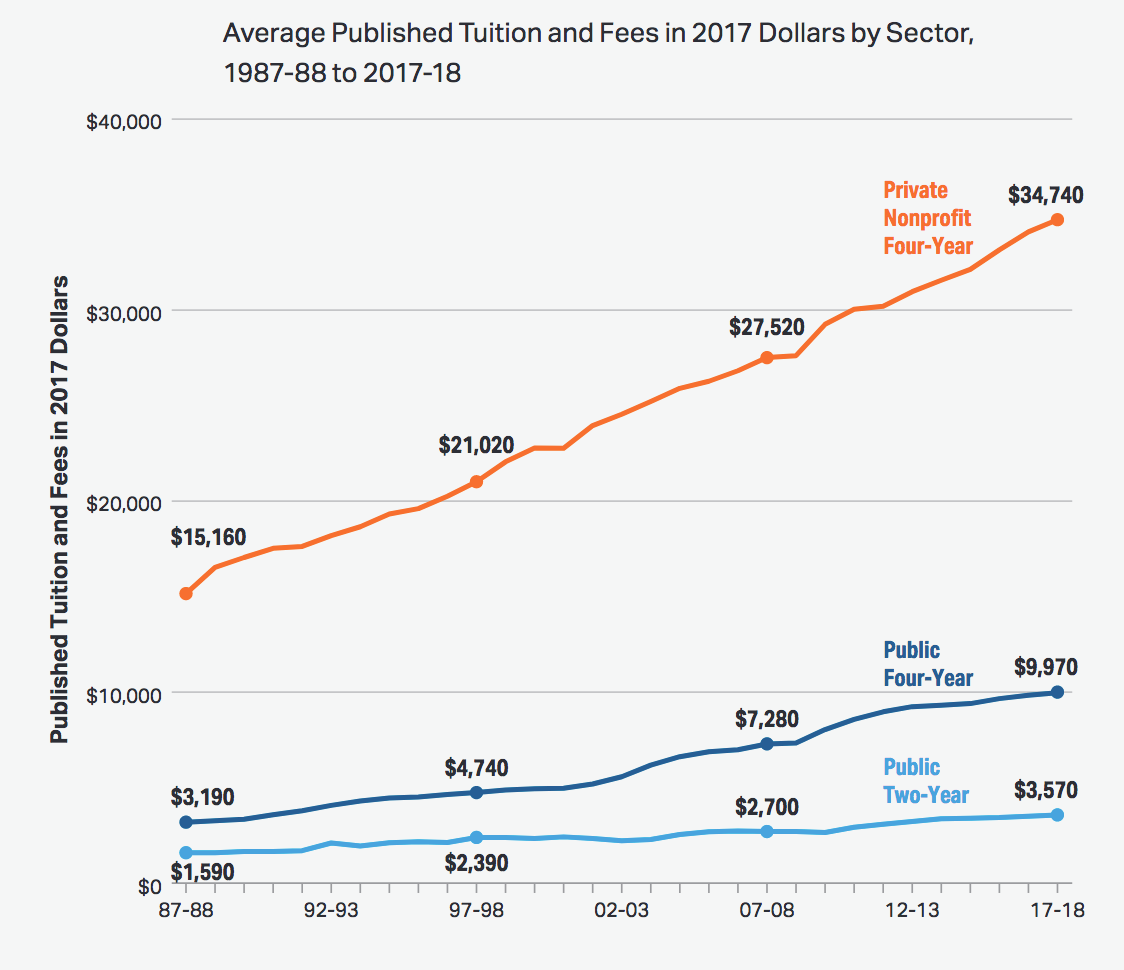
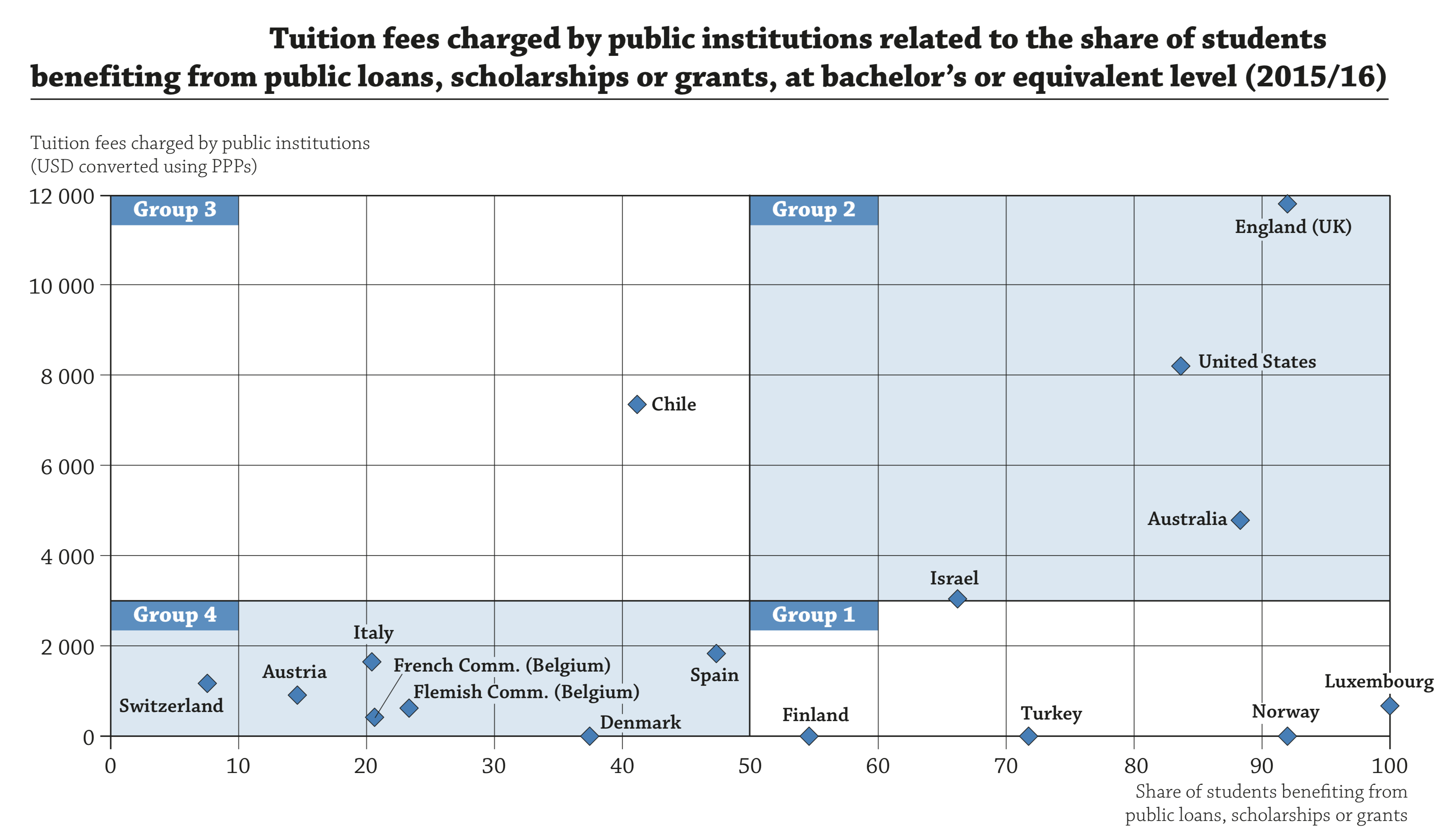
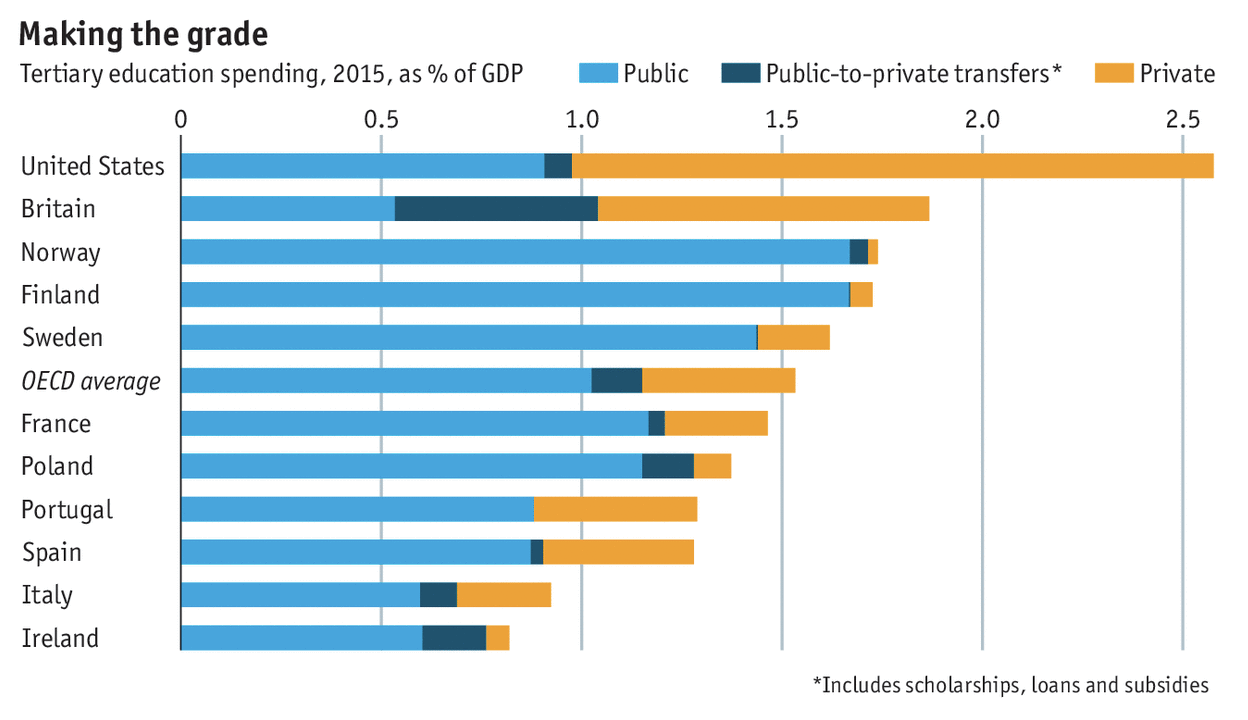
INFRASTRUCTURE SPENDING
Government expenditures, in particular public investment, have been crowded out by social spending in all Western countries. Benoit Cœuré, a board member of the ECB, summarized it well while visiting the University of California, Berkeley: “Public investment, in particular in infrastructure and education, […] an additional source of stronger growth of current as well as potential output, is also not being accorded much of a role, as advanced countries tend to see this as a preferred source for cutting high public deficits.” Cœuré
But the unfortunate political reality is that infrastructure, no matter how critical for the long-term well-being of economies, is the easiest budget line to cut as it is only in the long term that the negative consequences will be felt. Meanwhile, that extra room in the budget gets spent on programs that bring instant gratification.
Since the ’70s, U.S. federal spending on transportation and water infrastructure has decreased from 2.5% of GDP to 1.5% of GDP, while maintenance budgets have simultaneously fallen. According to Federal Reserve figures, net federal government non-defense investment and net state and local government investment68 are at their lowest level since World War II. They have fallen to a quarter of the level of the early ’70s. Congressional Budget Office
Similarly, in Europe, governments continue to underinvest in digital and transportation infrastructure. The European Investment Bank recently reported that government investment remained at a 20-year low of 2.7 per cent of EU GDP. The larger countries – France, Italy and Germany – reduced investments by between 15 to 20 percent over that period. The Chief Economist of the EIB concluded: “Much more needs to be done to put the issue of infrastructure spending into the political narrative, to explain that it’s for the good of the long-term health of the economy.” EIB Financial Times
Indeed, the level of infrastructure spending has been so low that even maintenance was not properly funded, leading to a number of mishaps from the closing of tunnels in Brussels69, to train accidents, to the collapse of viaducts. In Italy alone, 11 bridges and viaducts have collapsed between 2013 to 2018, causing scores of casualties. Italy is well known for having had to limit maintenance of its infrastructure because of budgetary issues Reuters.
In the U.S., the Federal Highway Administration estimated in a 2013 report that 25% of the country’s 600,000 bridges should be replaced or profoundly modified.70 The same goes for airports, pipelines, and most other categories of critical infrastructure. In fact, the U.S. Society of Civil Engineers has given the country’s infrastructure a grade of D+ ASCE, 2017.
And yet infrastructure investment would more than pay for itself over time. An IMF study concluded that in advanced economies, increases in infrastructure investment of 1% GDP raises output by 0.4% immediately and by 1.5% within four years. In a period of anemic demand, this is significant. Further, it means that economic output is raised without any long-term increase in the debt-to-GDP ratio IMF.
Whether spent on roads, high-speed rail, or even ensuring that all citizens have fast internet access, government investments would pay off handsomely.
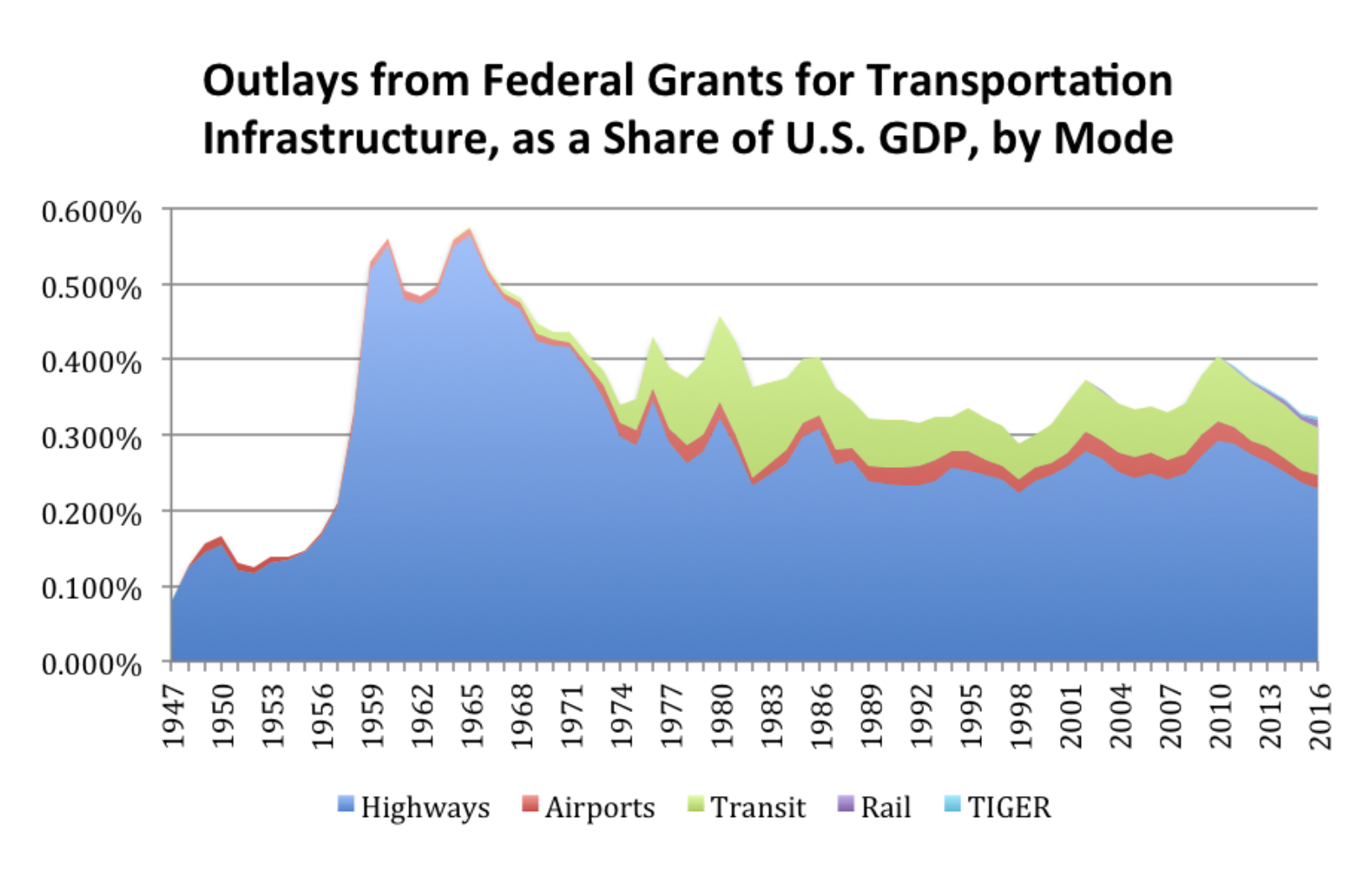
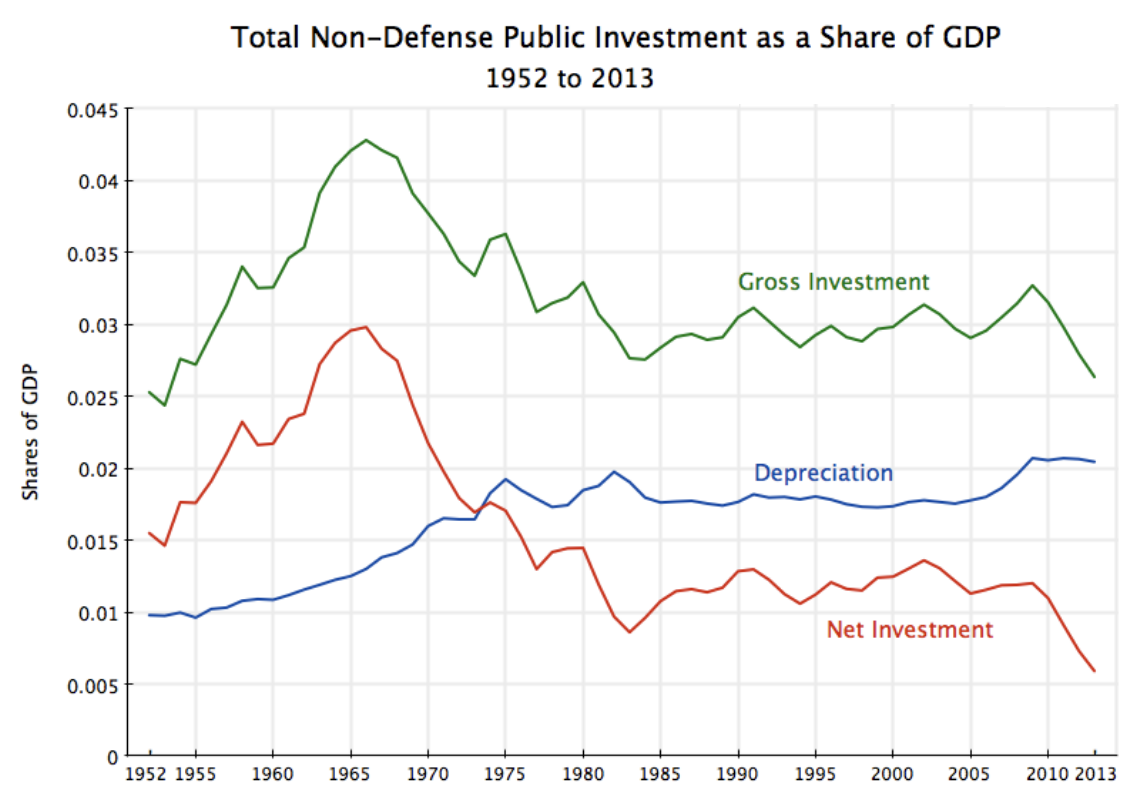
DECREASING INFRASTRUCTURE INVESTMENT: THE BELGIAN EXAMPLE
According to a recent report, Belgium’s investment in infrastructure from 2010 to 2013 was about 0.6% of GDP, a new low. In fact, the country’s infrastructure investment has been declining since the 1980’s when it was twice its current level.
Belgian infrastructure has been so undermaintained that according to the country’s leading newspaper, one out of four kilometers of rail track, one electric substation out of five, and half of the railway crossings need to be replaced. Meanwhile, 80% of bridge masonry dates back to WWI and the average age of tunnels is nearly 90 years old. Recently Brussels tunnels had to be closed to traffic for safety reasons after 20 years of non-maintenance, creating massive traffic jams. The National airport was well outside Brussels when it was built in the 1940s, but the city has expanded close enough to it that it now presents traffic and noise nuisances to residents, who can rightfully ask after 70 years why a new airport has not been built at a further distance. The European Commission summarized the situation simply: ‘substandard infrastructure and lasting bottlenecks that undermine productivity growth’. Le Soir, 2016
To understand this mess, aggrieved Belgians need look no further than fiscal policy. Public investment has been crowded out by bailouts for senile industries, debt servicing, and social spending. As the investment budget shrank, infrastructure was the first to get cut. The last nails in the coffin were the poorly devised budget rules of the Maastricht criteria. Rather than a golden rule which would have allowed for financing of projects aimed at the future, this approach took a basic accounting view that expenses needed to be balanced. It failed to account for the future revenues that investment expenses would generate, or indeed the damage to growth that slashing investment would cause. As a result, the Belgian government, like many in Europe, cut not only investments but also basic maintenance.
Indeed, this was not a unique Belgian, or even European, phenomenon. According to the IMF, advanced economies’ public investment decreased from 5% of GDP in the ’60s to 3% in 2012. Not surprisingly, reports indicate the quality of their infrastructure has stagnated or deteriorated. IMF
Economists like to differentiate between the impact of efficient and inefficient public investments. The former create much more growth, paying for themselves and beyond, while the later just add to overcapacity, costing more than they yield. The good news is that we have been underinvesting for so long that there are now plenty of opportunities to pursue the most efficient public investments – to pick the proverbial low-hanging fruits. With so much infrastructure so badly needed, there is little risk of wasting money on bridges to nowhere.
Given the chaos caused by the crumbling infrastructure, the Belgian government is finally moving to restore at least part of it. A new plan for repairing the country’s crumbling tunnels over the next 15 years has been put forward, which led, in a typically Belgian surrealistic approach, to a large celebratory rave party in a newly refurbished tunnel. This is a good first step, but it is not nearly enough.
HOW TO TAX, OR WHY IT MATTERS HOW YOU SKIN THE CAT
Nearly as important as how the money gets spent is how the money was collected in the first place. Taxation – state capture of produced income or retained wealth – should pursue several objectives. It should be minimally disruptive to the economy and it should avoid causing resource misallocations, or even worse, causing resources to sit idle. It should be an instrument for reinforcing other governmental aims, such as breaking monopolies or capturing part of “miraculous” windfalls. And it should be socially just, promoting a cohesive society where wealth is recognized as legitimate.
In order to respect this broad mandate, one would have to tax “undeserved” wealth harshly, through taxation on wealth and, in particular, inheritances. Gains from rents incurred by virtue of extraordinary situations, such as factitious real estate supply shortages, or monopolistic behavior in say pharmaceuticals, need to be captured by the community, both as a source of income and as a deterrent. Setting customs duties aside, consumption should only be taxed after these other revenue sources have been exploited, possibly with a variable rate depending on the damage done to the environment (a Pigouvian tax) or the necessity level of some goods as opposed to others (i.e., taxing luxury goods at a higher rate than basic necessities). Taxation on income should come as a last resort. In particular, taxes that make marginally profitable jobs nonviable – causing unemployment and shadow economy participation – should be avoided at all costs.
Western governments have been falling short of these ideals.
Overall, taxation in the OECD has markedly increased since the ’70s, from about 25% of GDP to about 35% of GDP by the late 90’s, a level around which it has hovered since then. The greatest increase has occurred in Japan (18% of GDP to 30%), and the highest taxing countries in the G7 are France and Italy (40-45% of GDP). The U.S. federal government alone has maintained a relatively steady taxation level around 25% GDP. OECD
A misunderstood aspect of the growing populist dissent is this increased taxation, especially on work and means necessary to work, as perhaps best illustrated by the Tea Party movement in the U.S. The level of taxation and the taxation mix has become steadily more hostile to a middle class striving to achieve a higher status through work. This in turn has led to the growth of the “shadow” economy as people tried to circumvent an increasingly hostile tax environment while their basic expenses increased and wages stagnated.
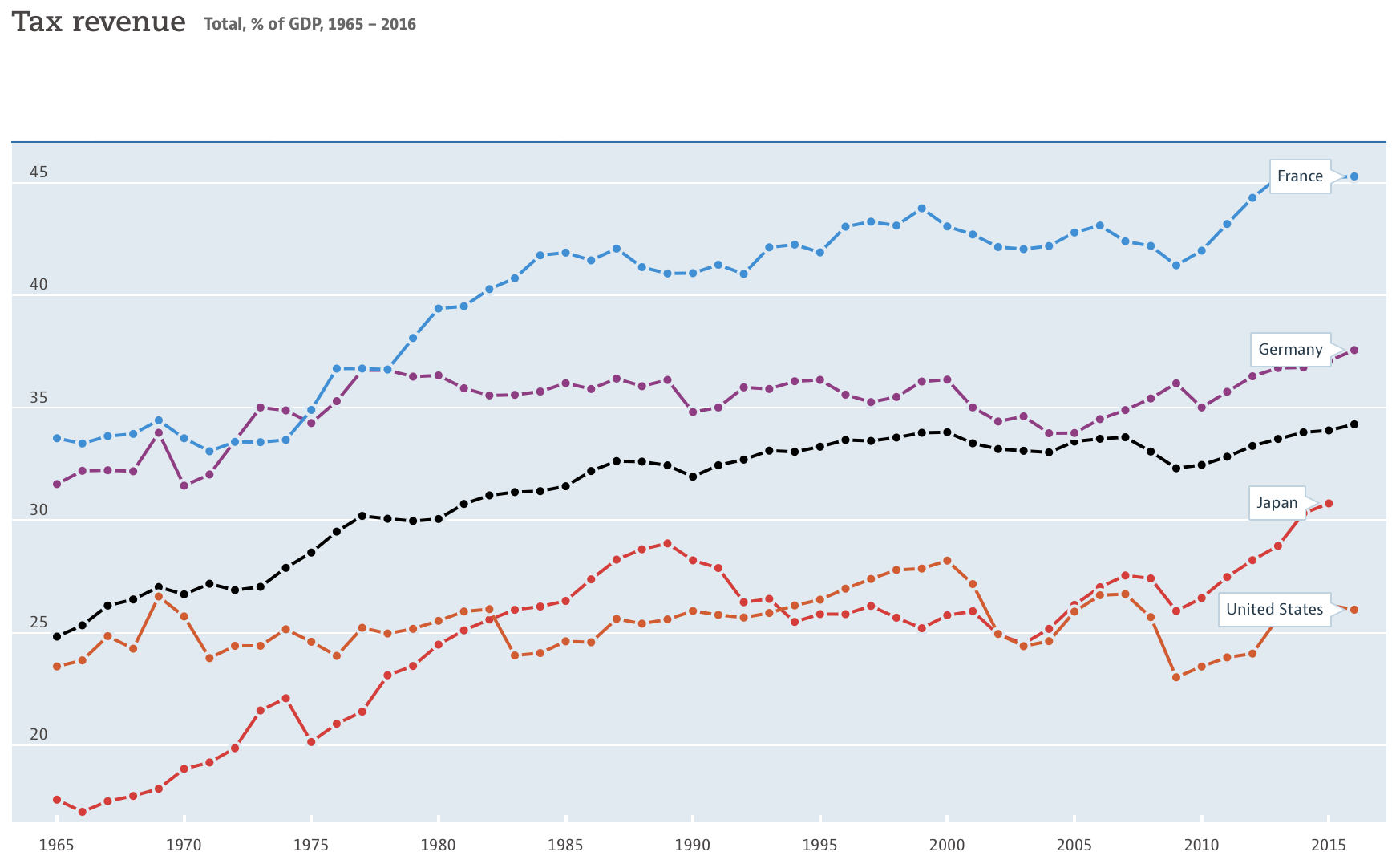
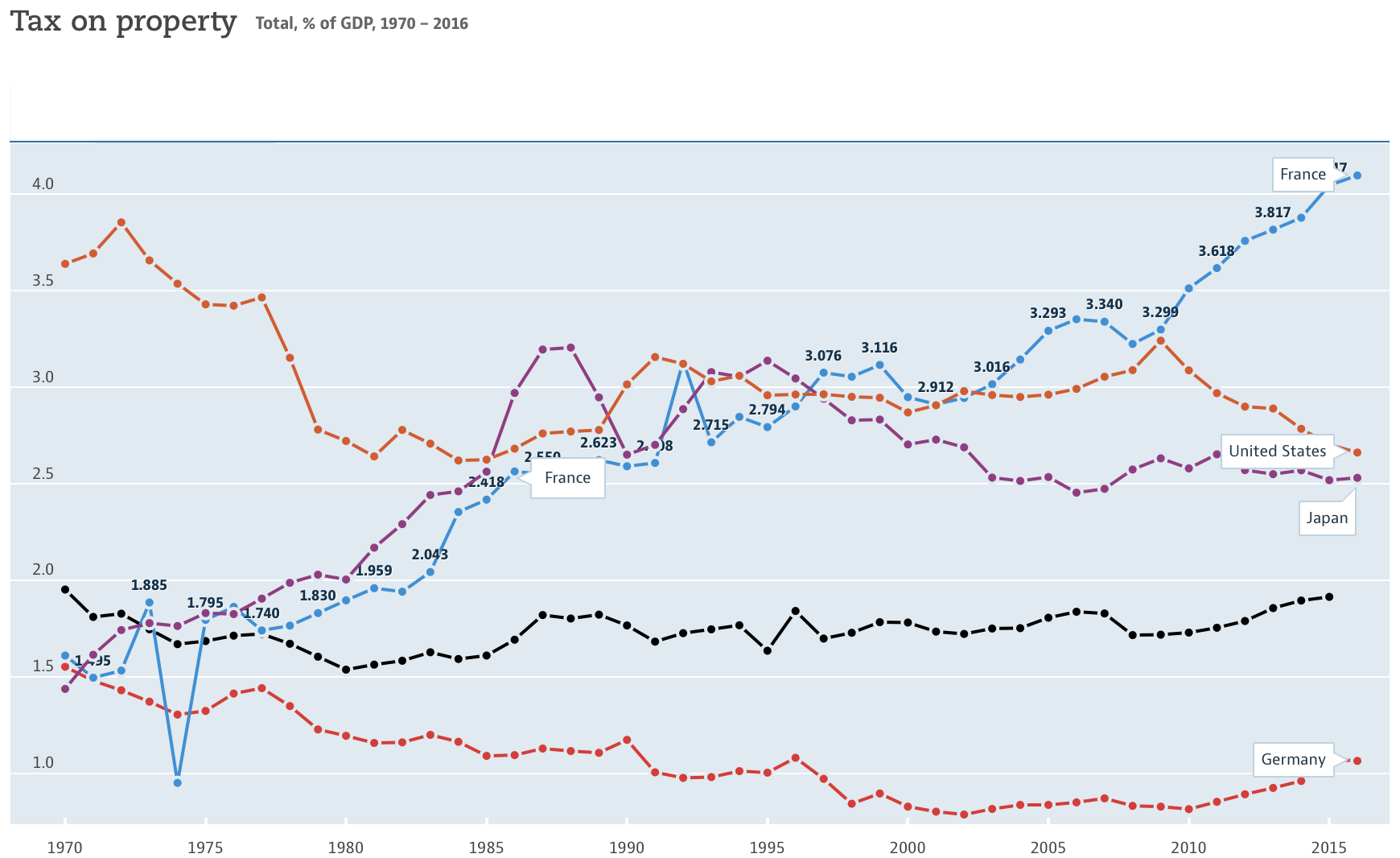
WEALTH, GIFT, AND ESTATE TAX
While taxation went up, not all forms of taxation increased in the same way. Taxation on idle wealth and inheritance, has in practice, if not disappeared, become marginal.
While the “death” tax may appear to be unfair, for gains that were already taxed get taxed again, it can also be argued to be the fairest tax. The estate recipient performed no work that will justify the fact he or she is now getting wealthy. Not only does it discourage the recipient from working and contributing as aggressively as he or she otherwise would have, it also sends a strong signal, particularly with a high income tax, that the system is not just unequal but fundamentally unfair. This is particularly the case if the creation of new wealth, through income, is severely taxed.
Successive governments have created and enhanced loophole after loophole, which citizens rationally exploit. De facto, despite high headline rates and increased wealth concentration, the amount of estate tax collected as a percentage of the economy is at historical lows. Wealth taxes as such exist only in a couple of countries, leading to tax arbitrage. It is true that wealth taxes generate questions as to the valuation and somewhat inquisitive nature of the assessment. That could be addressed by a fixed tax on real estate and securities, for instance. But there again, with the notable exception of the U.S., taxation on real estate has become largely symbolic. The starkest example is given by the UK, where the local councils’ fixed real estate taxes have essentially become a poll tax rather than a tax on real estate’s value, a practice that has as a side effect the encouraging of a real estate bubble. Inheriting in the most valuable part of London has become a non-taxable event. Even in the U.S., where real estate taxation is “real” and has contributed to maintaining some sense of sanity on real estate prices, severe distortions, as introduced by Proposition 1371, exist.
Overall, and incredibly, while both total wealth and real estate values have grown by several multiples in the OECD since 1970, total property taxation72 has remained steady at around 2% of GDP per year. So rather than having a ‘cyclical’ view of property tax, increasing it during bubbles to prevent excess, the opposite was, faction effect, done. Meanwhile tax on production, particularly social taxes on labor, has risen with devastating effects. Tax Foundation OECD
CORPORATE TAX
Corporate taxes have fallen in the developed world since 1970, even as corporate profits have grown. In the U.S., for instance, from 1970 to 2015, companies’ after-tax profit as a percentage of GDP increased from approximately 5% of GDP to 8.5%. Simultaneously, the intake from corporate taxation dropped from 3.4% of GDP to 1.9%. In other parts of the developed world the explosion of corporate profits has offset declining corporate tax rates, leading to a marginal increase in total corporate tax revenues from 2.2% of GDP in 1970 to 2.8% in 2015. U.S. Bureau of Economic Analysis Tax Foundation
So, on an aggregate basis, while companies’ profits are higher than ever, the amount of corporate tax collected as a percentage of the economy is closer to historic lows. It would have been normal to expect the opposite, that swelling profit would translate into higher relative fiscal contribution, but it hasn’t. The beneficiaries have been company owners, that is, the wealthiest among us.
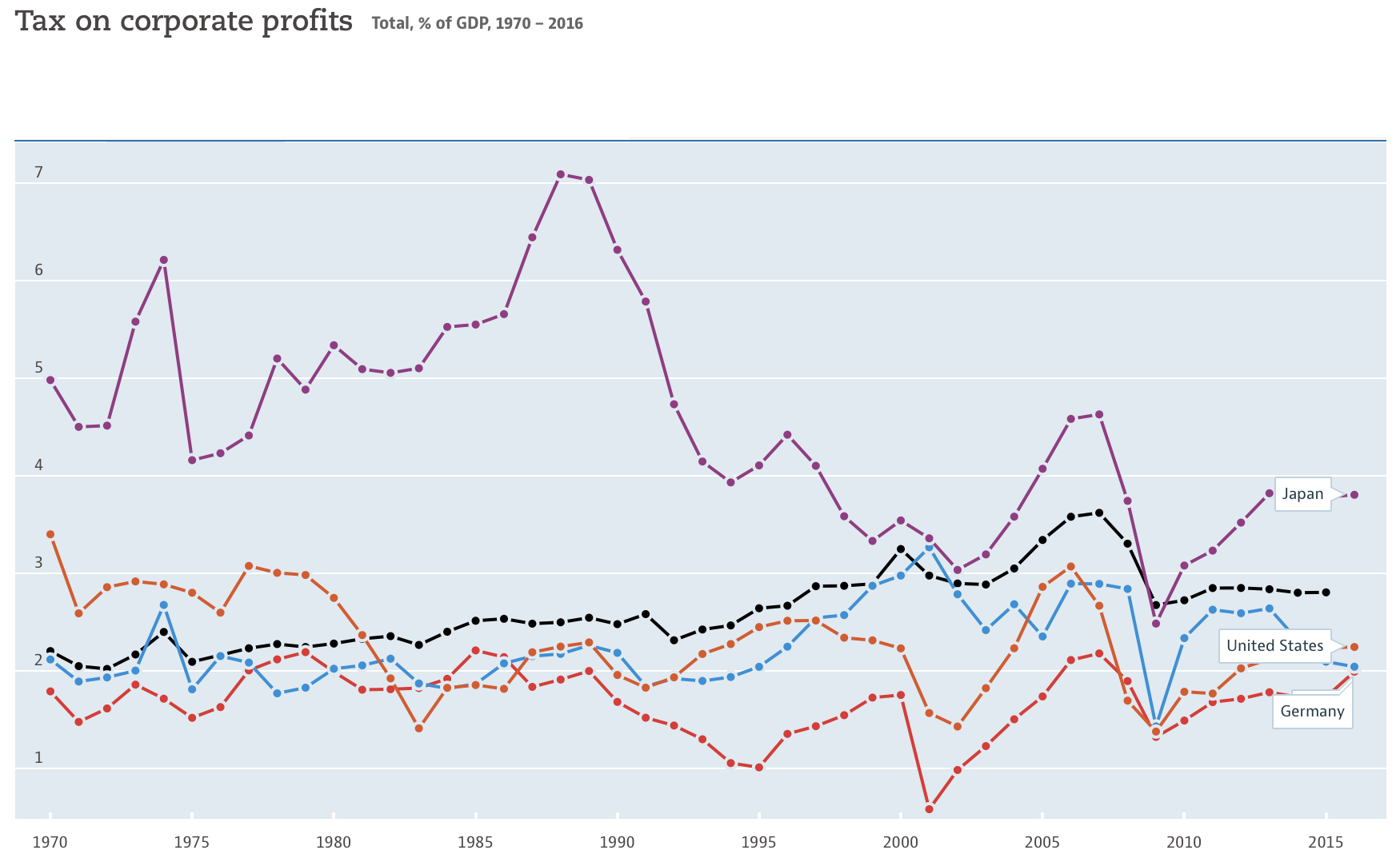
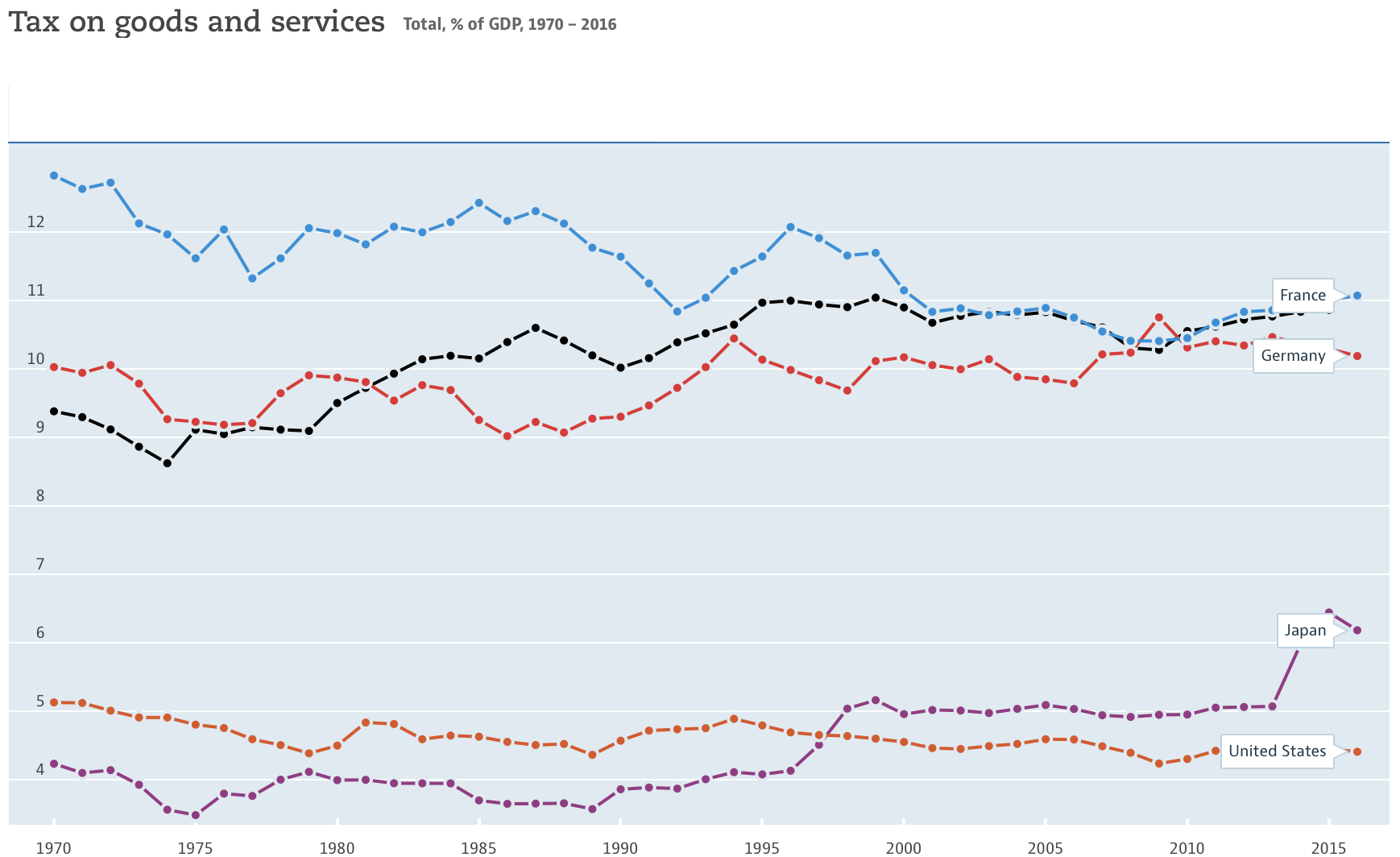
TAXES ON CONSUMPTION AND WORK
While tax rates or revenues levied on wealth and corporations have fallen, taxes on labor and consumption have grown.
Consumption tax comes in two large categories. Sales tax and Value added tax (VAT). VAT is more cumbersome to administer, but it has two great advantages. First, it does not favor a distribution model by reducing the number of transactions along the distribution chain. Second, it acts as a level field both in imports and exports by not penalizing domestic companies.
Consumption taxes have grown steadily as a source of government income. In 1965 they accounted for 12% of OECD countries tax revenues, compared to over 20% today. Consumption can worsen inequalities as consumption is a necessity for all, but for wealthy savers it affects a smaller portion of their income. To alleviate this, different range of taxes according to the category of goods have sometimes been introduced. OECD
More striking have been the tax burdens piled on top of workers, a remarkable practice for governments that are supposed to be encouraging full employment rather than disincentivizing it.
The increase in taxation on individual income has primarily taken place through social security taxes on wages. In the OECD, direct taxes on wages increased only marginally from 1970 to today, going from slightly over 9% of GDP to between 10% and 11%. But social security contributions nearly doubled from around 5% of GDP to 9%. They account for half of the total increase in the taxation during this period. Overall, taxes on labor increased by close to 50% from approximately 14% of GDP to 20%.
This increased taxation and emphasis on taxing income, particularly of low wages through social security taxes, results from governments that are desperate for revenues and prefer to use “hidden” taxes on wages rather than increase more visible sources of taxation, even when they are less damaging.
The direct and indirect tax hikes on working people have led to several disruptions in the economy. The tax wedge is computed by looking at what an individual receives after all taxes, compared to what his employer is paying him.
The tax wedge increase has been dramatic, and there have been a number of countries where, for an average factory worker, it has reached 50% once all taxes and contributions paid by both employer and employee are taken into account. In the OECD, the tax wedge for an average single individual in 2016 stands just short of 40%, that is that employees get paid about two-thirds of what they really cost. In some countries like Belgium, the tax wedge is over 50%. Of course, for higher salaries the numbers would be considerably higher, but the levels for even low-wage workers are astounding.
The growth of the tax wedge has contributed to increased unemployment for the most vulnerable, especially wherever unemployment benefits have been generous, as the incentive to work has been diminished through state intervention. It has been estimated that an increase in 10% of the tax wedge leads to increase in unemployment of 2% of the adult population. Labor tax is putting a number of the less skilled in a situation where they either become unemployed or unwilling to work, for they are taking home barely enough compensation to survive. Nickell
Another consequence has been the growth of the undeclared (otherwise referred to as non-observable or “shadow”) economy and the do-it-yourself economy. By definition, the size of the shadow economy is difficult to estimate and a matter of debate. What is clear is that the size of the shadow economy in OECD countries today is large.
More important is its evolution. Even in a country as well organized and with as strong a sense of duty as Germany, it is estimated that the size of the shadow economy has tripled since the ’70s, with the shadow economy reaching 17% of GDP and the do-it-yourself economy 5% of GDP by 2005. The shadow economy of course includes illegal activity, but also activities that have been crowded out from legal reporting because of the high level of tax, in particular the tax wedge. The DIY economy is another symptom of high taxation, as the high cost of labor induced by the tax wedge pushed many consumers to undertake activities they are not qualified for in order to avoid the outrageous cost of specialized labor. This phenomenon at least partially explains the success of chains like IKEA, which offers consumers cheap furniture they must assemble themselves. Buhn
The pitfalls of the shadow economy, and its growth in recent decades, go well beyond a problem of tax collection. On the one hand it creates unfair competition for some of the least productive people in our society who remain on the ‘legal side.’ At the same time, it also pushes a large number of citizens into illegality, potentially losing all social protection in the process. This has been good for the most well-off, who are now able to hire nannies and maids at bargain prices without paying taxes and without following basic labor laws. But it also creates a class of laborers at the margins of society having all but de-officialized some professions. Are there really still officially declared maids and nannies in the OECD? Clearly a vast majority are undeclared. Many of the citizens have been pushed into earning their livings illegally by an oppressive, ill-conceived tax system designed to extract from the weakest. This is allegedly done to finance social security, but, ironically, it pushes vast numbers of citizens into lives of social precariousness.
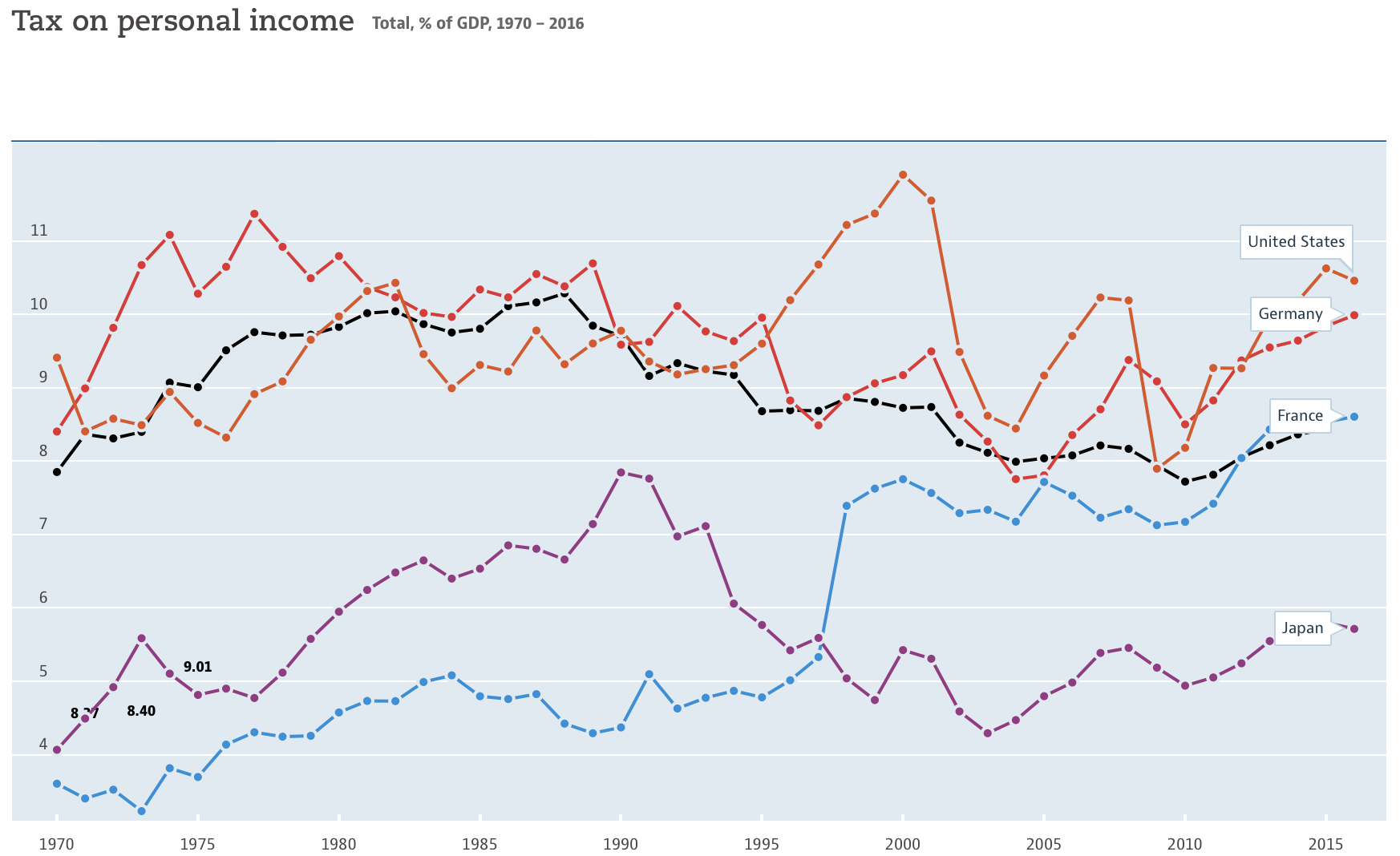
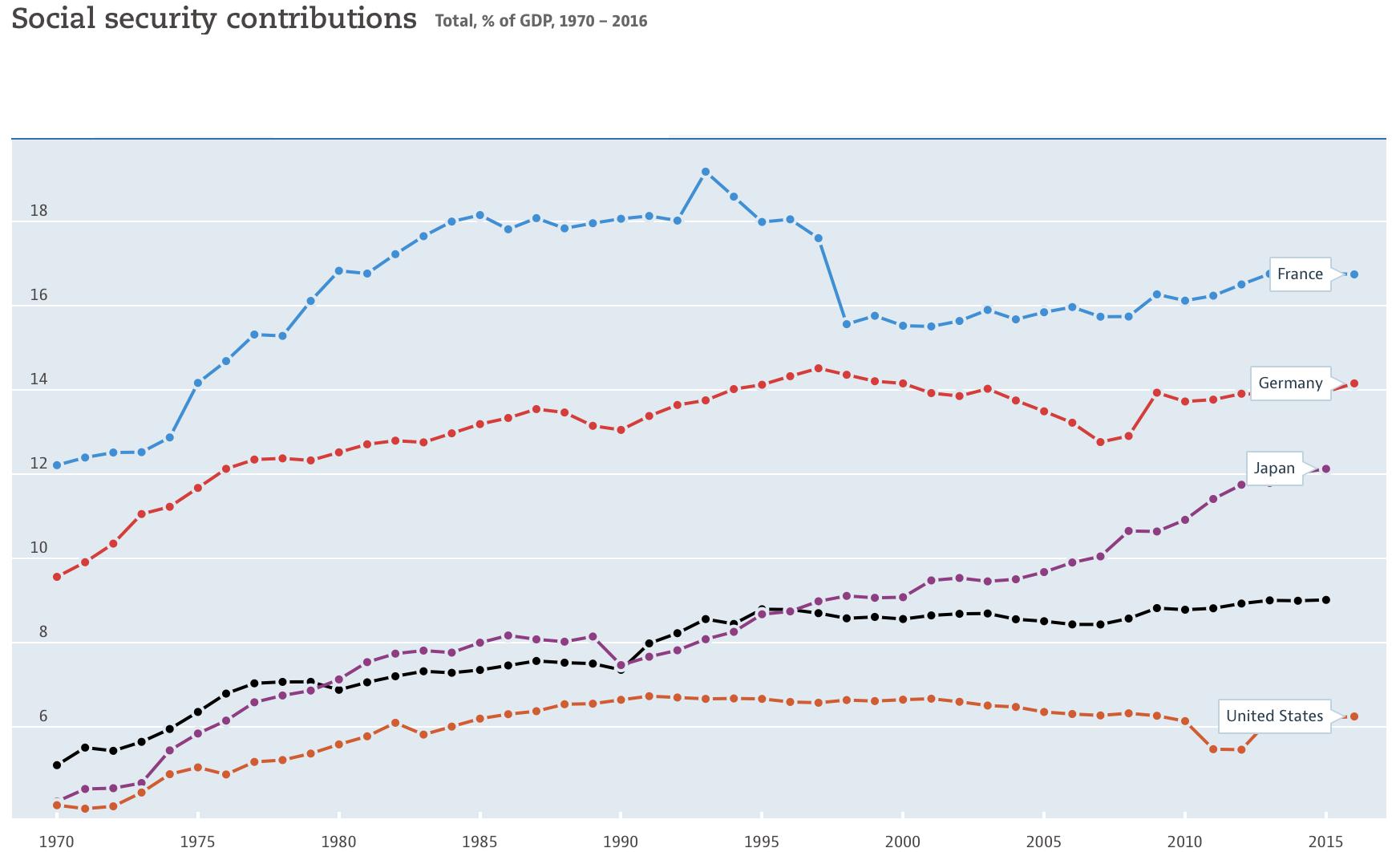
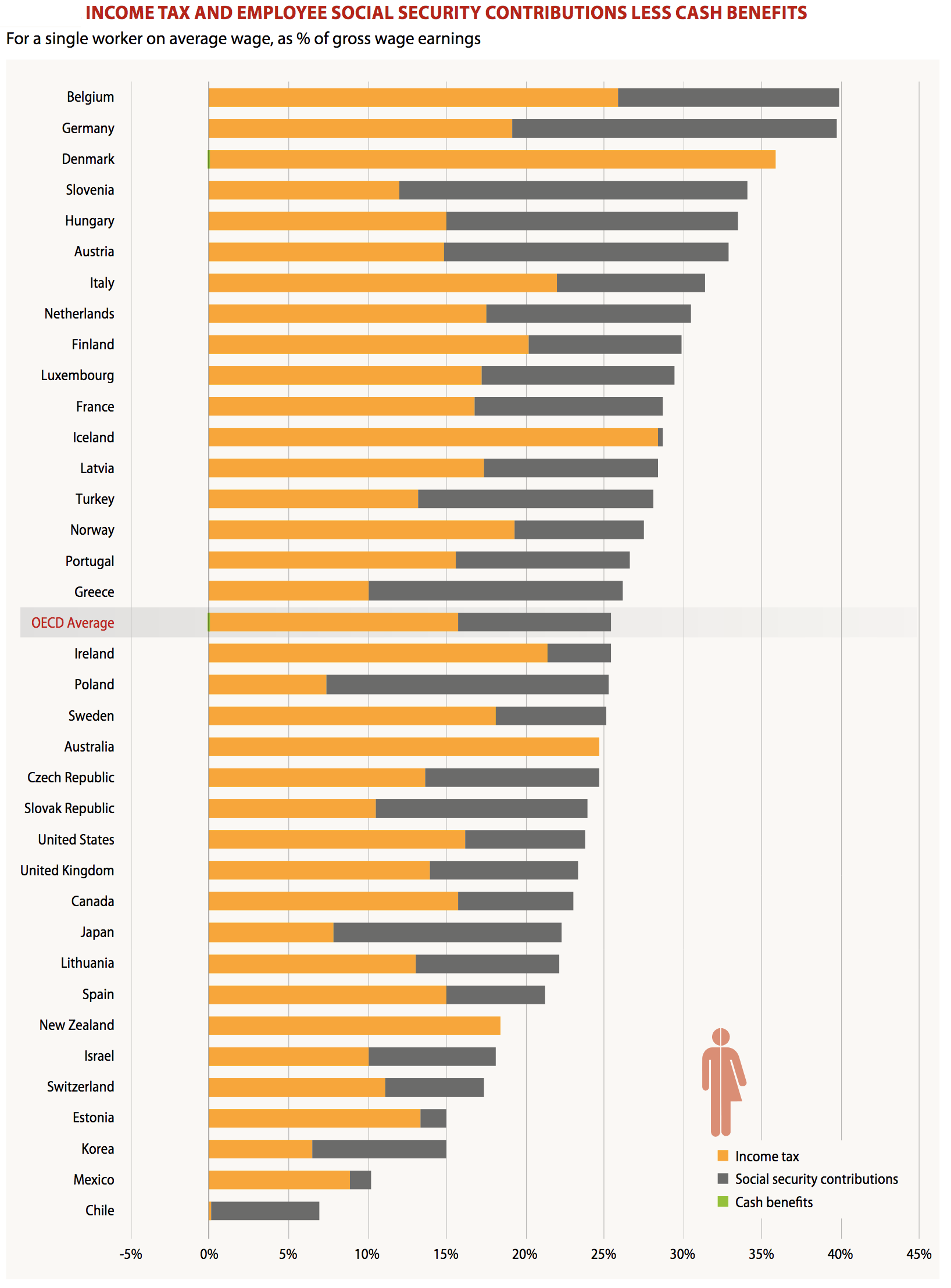
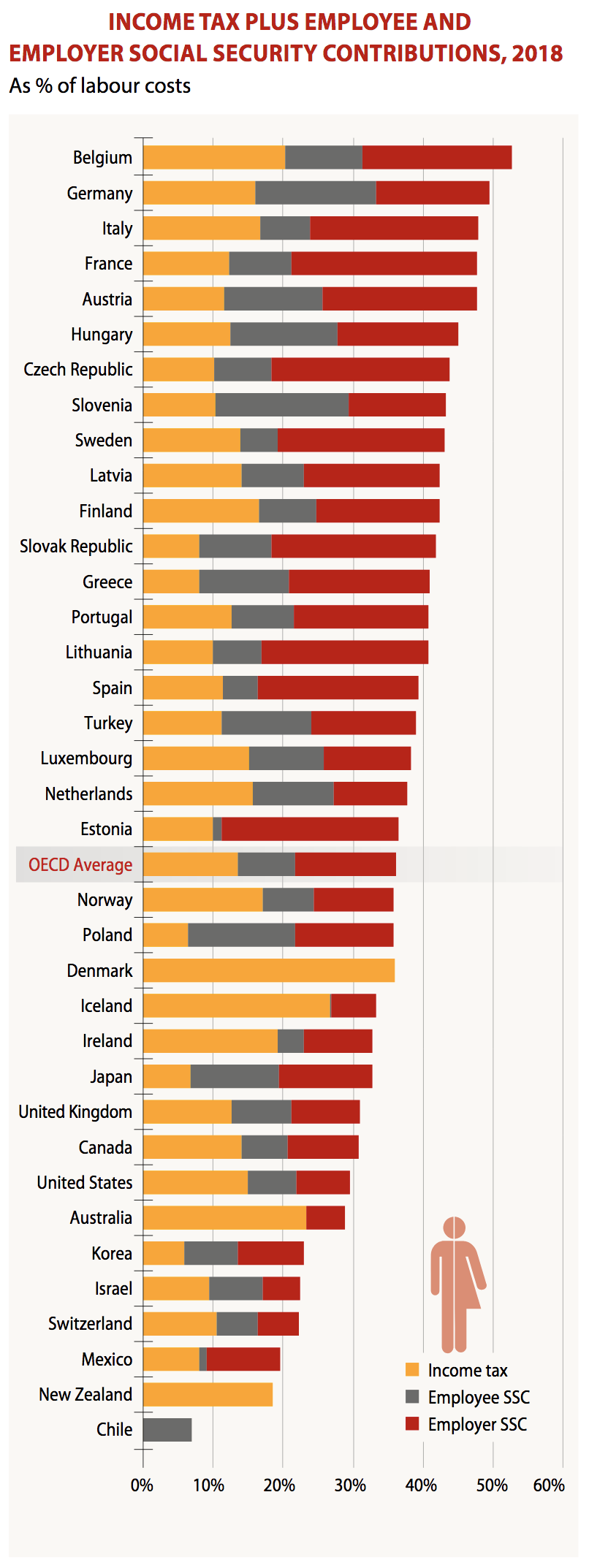
THE GOVERNMENT RESPONSE: IGNORE AND TAX SHIFT
It is relevant again in understanding the populist wave to contrast the increased tax burdens on labor and consumption (from just above 20% of GDP in the OCED in 1970 to more than 30% of GDP today) affecting the majority, and the decrease in corporate tax alongside stable wealth taxes despite higher profits and wealth. It is difficult to avoid the conclusion that the majority has been taxed substantially more and owners of capital less. Of course, capital being mobile in a globalized world, this may have been, if not the only route, certainly the easiest for governments to take in order to prevent capital flight.
Some governments are starting to at least alleviate the effect of this taxation policy by changing the mix between consumption tax and labor tax. It is still taxing the majority, but at least in a less hurtful way. The idea is to shift income taxes to sales taxes on goods and services. This is a good idea, for it encourages production over consumption and ‘equalizes’ the cost of producers with foreign competitors selling in the developed market but failing to contribute to the social protection in these markets. Indeed, a number of projects have looked at levying a ‘social VAT’ (value added tax) that would shift the cost of social protection contributions entirely to the consumption side.
CASE STUDY: JAPAN
In contemplating the end of fiscal policy, it is worth considering the case of Japan. Its government has always spent significantly more than it has taken in, with deficits of 4-5% of GDP the norm in the ’70s and even during the late ’80s bubble (but these were years of higher inflation and higher growth, limiting the deficit’s impact on the debt to GDP ratio). Since the bursting of the bubble, successive Japanese government have embarked on a series of fiscal stimulus programs. Social spending increased from 10% of GDP in the early ’90s to 25% today. Part of this has been due to the aging of the population, but a large part results from politicians’ efforts to ease the pain of the post-bubble meltdown and to ‘buy votes’, for instance by providing overgenerous programs to the country’s electorally overrepresented countryside.
As a result of additional social spending, the deficit has risen to close to 10 percent of GDP every year since 2010, and the national debt has risen from just above 60% of GDP in 1990 to well over 200% today. Public debt interest payments, despite a very low interest rate, represent a quarter of the national budget. Health, pension and other social spending represent another third. After transfers to local government, the central state is left with only about a quarter of its total budget to fund all its functions. Social spending can no longer keep up, and the poverty rate among the working age population has jumped from the low teens to the mid-teens.
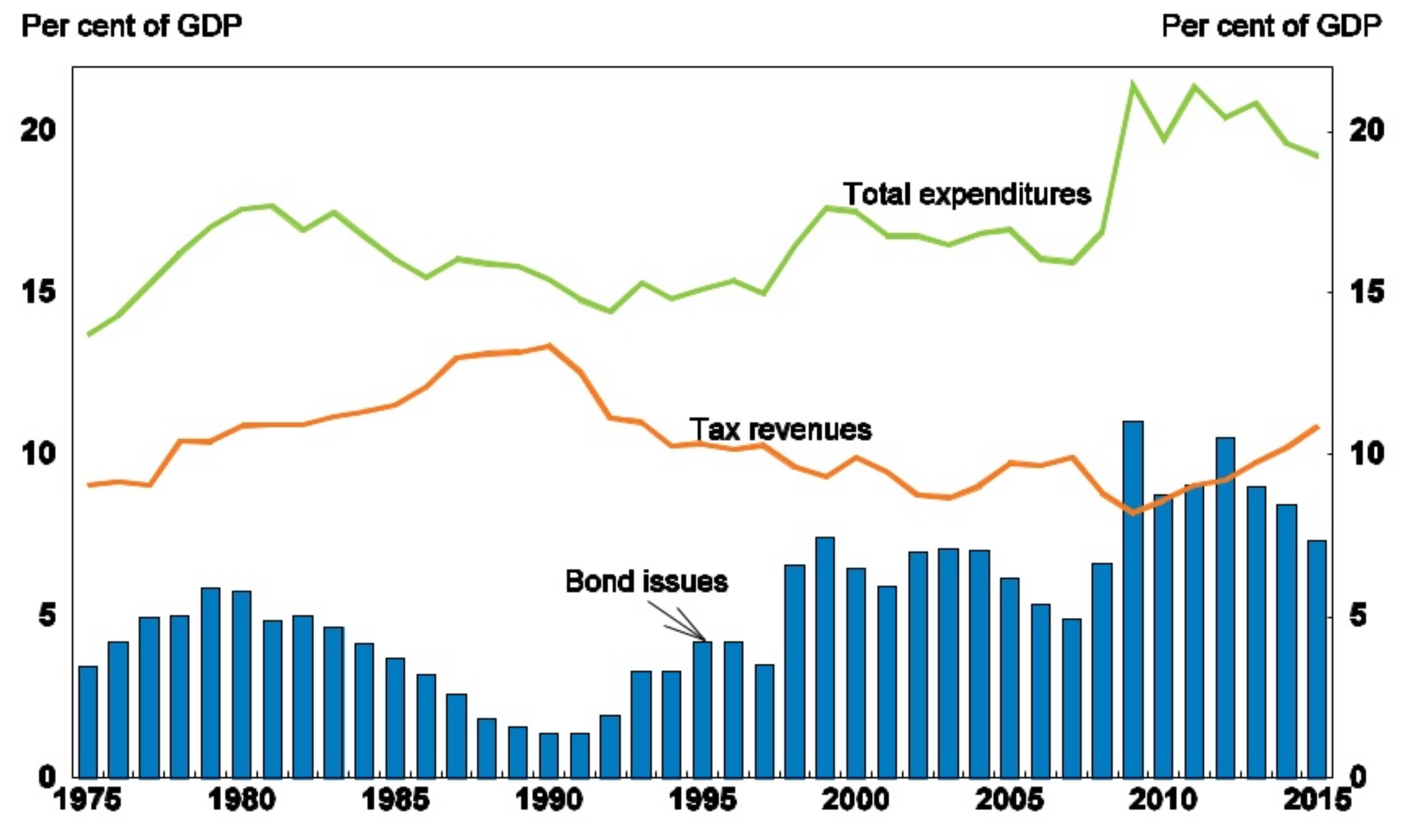
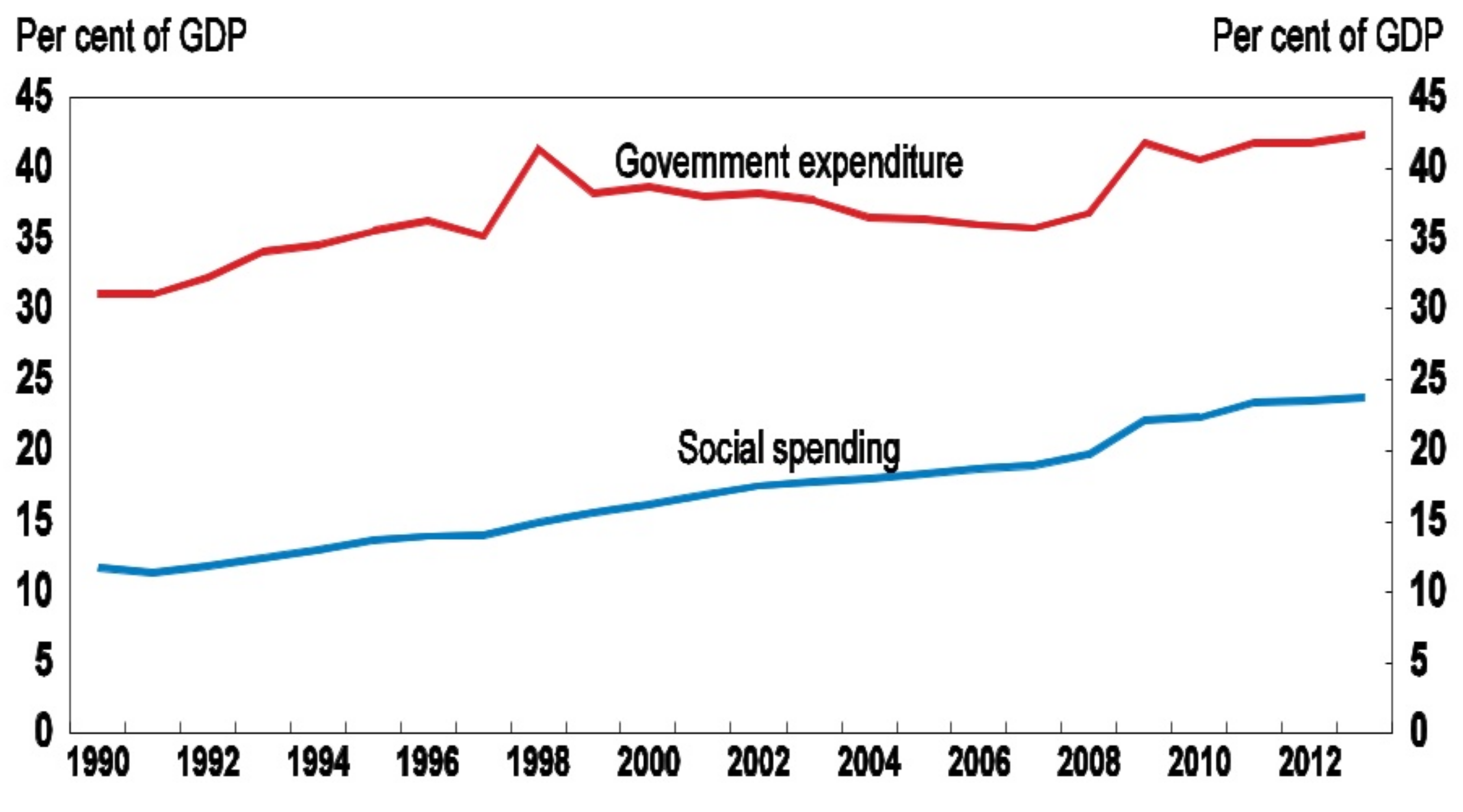
THE ADJUSTMENT VARIABLE: DEBT
Year after year, from the 1970s to the end of the 20th century, the pressure to increase social outlays to compensate for increased pressure on the most vulnerable in society has led to tax increases and significant deficits. After they reached the maximum tolerable level of labor tax and increased debt levels, Western governments started to control spending by the beginning of the millennium, only to be pushed back into the red on account of the 2007-08 financial crisis.
As a result, the debt-to-GDP ratio in OECD states has steadily increased, except for occasional periods of stagnation. In the U.S., the national debt has increased from below 40% of GDP in 1970 to over 100% today, a level not seen since World War II.
The increase of the debt-to-GDP ratio has had significant consequences. Interest payments, particularly in the ’80s and ’90s, have crowded out states’ normal budgets. This has sometimes been formalized through the adoption of ill-considered constraints (think of the Maastricht criteria), and sometimes just been forced upon states by the markets. In all cases the result has been cuts in the wrong kind of spending. It is much easier to cut education and infrastructure spending than to say, increase the pension age in line with increased life expectancy. But the result has been a corrosion of long-term economic growth potential, as well as of the sovereignty of the state.
It is striking that some of the most fragile states in Europe, such as Belgium and Italy, are among the most indebted. Given these nations’ inherent lack of cohesion, their governments have historically used and abused budget deficits to a greater extent than their more unified continental neighbors. As deficits have accumulated into burdensome debts, these states have largely been crippled. This, in turn, has fanned the flames of separatist movements, as the wealthiest regions realized they were overtaxed yet receiving little state investment, or even normal state functions.
Fiscal policy has been so badly abused that states have, in a sense, mismanaged it out of existence. In effect, the debt-to-GDP ratio, the highest since WWII, is so elevated that there is little room to increase deficits. Doing so would create a spike in interest rates that would itself generate more damage. We already got a glimpse of this brave new world in the last crisis, when fiscal policy was abandoned, or rather became conditional to monetary financing, and monetary policy become the “only game in town.” In the next chapter, we will explore the consequences of this new reality.

